Regeneration nation

January/February 2023 WINTER OF CONTENT Finding comfort in slow cooking RESTAURANT REVIEWS Four hot finds for your 2023 hit list STAYCATION GUIDE Where to eat, drink and stay in Wells FREE Take me home Read more at food-mag.co.uk Issue 194 The future of food and farming?





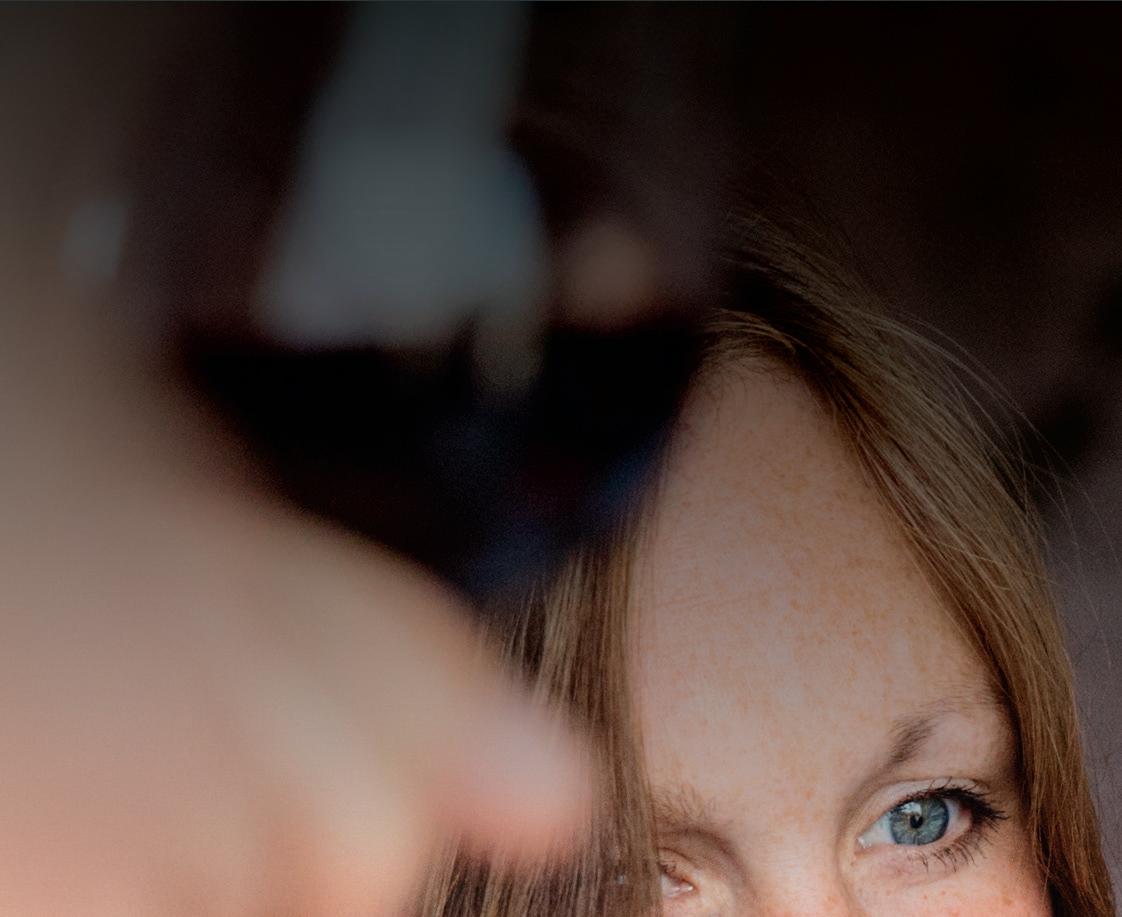

Join one of the South West Wine School’s Wine & Spirit Education Trust courses at Darts Farm. Level 1 starts on Friday 3rd March 2023 Level 2 starts on Friday 27th January 2023 Level 3 (new for 2023 at Darts Farm) starts on Monday 13th March 2023
deliciously sociable way to expand your wine knowledge See the full list of courses (and book) online www.southwestwineschool.co.uk
A
FOOD
Issue 194
Published December 2022 food‑mag.co.uk @foodmagazinesw @food_mag Facebook‑F foodmagazinesw
PUBLISHER
Salt Media ideas@saltmedia.co.uk 01271 859299 saltmedia.co.uk
EDITOR
Kathryn Lewis
EDITORIAL
Abi Manning Melissa Morris Rosanna Rothery Melissa Stewart Selena Young
EDITORIAL DIRECTOR Jo Rees

ADVERTISING
Nick Cooper Claire Fegan 01271 859182
PUBLISHING
Charlotte Cummins Tamsin Powell
ACCOUNTS
Richard Bailey
PHOTOGRAPHY
Matt Austin
COVER Matt Austin for The Collective at Woolsery
THANKS
Thanks to our clients for supporting the magazine that supports the South West's food and hospitality industry.
COPYRIGHT
The contents of this magazine are fully protected by copyright and may not be reproduced without permission.
DISCLAIMER
While every effort has been made to ensure that adverts, details and articles appear correctly, Food cannot accept responsibility for any loss or damage caused directly or indirectly by the contents of this publication. The views expressed in this magazine are not necessarily those of its publisher or editor.
PRINT
We're serious about protecting the planet, which is why we print using solvent‑free inks on FSC®‑certified paper, working with a printer that holds ISO14001 certification for environmental good practice.
Living in the South West, it's almost impossible to ignore the impact of agriculture; take a short drive or walk out of any town or city and you'll find yourself surrounded by rolling farmland.

Yet the familiar sight of fields of uniform crops could be swapped for a more diverse style of growing if regenerative farming lives up to its potential. I spoke to a few changemakers (page 8) to find out if this traditional way of farming might be the future for the South West.
It's easy to fall into a post Christmas slump at this time of year so, to ward off the January blues, Jo and Mel are taking comfort in the joys of the slow cooker. Flick to page 22 for recipe ideas and tips to get the most out of your machine.
HiIf you're looking to fill your 2023 restaurant hit list, you'll find plenty of inspiration via this issue's reviews. In Glastonbury, I discovered an old pub serving some of the best fusion food in the region, while Selena supped on sensational seafood in one of Bude's hidden gems. Get the low‑down from page 28.
As ever, you'll find lots of additional content including must‑make recipes, exclusive competitions and need‑to‑know '5 of the best' collections on food‑mag.co.uk.
Enjoy the issue.
Kathryn Lewis
Follow us on Instagram @foodmagazinesw
Regeneration nation, page 8












16 40 52 8 January & February 6 THE HIT LIST Latest foodie news and events. 8 REGENERATION NATION The future of food and farming? 16 STAYCATION GUIDE Where to eat, drink, stay and shop in Wells. 22 WINTER OF CONTENT Finding comfort in slow cooking. 28 REVIEWS New finds for your 2023 hit list. 40 WEEKEND COOKING Seasonal recipes from leading chefs, cookery tutors and producers. 52 WIN A Hix seafood feast and a winter escape on the Cornish coast. 5 / ISSUE 194

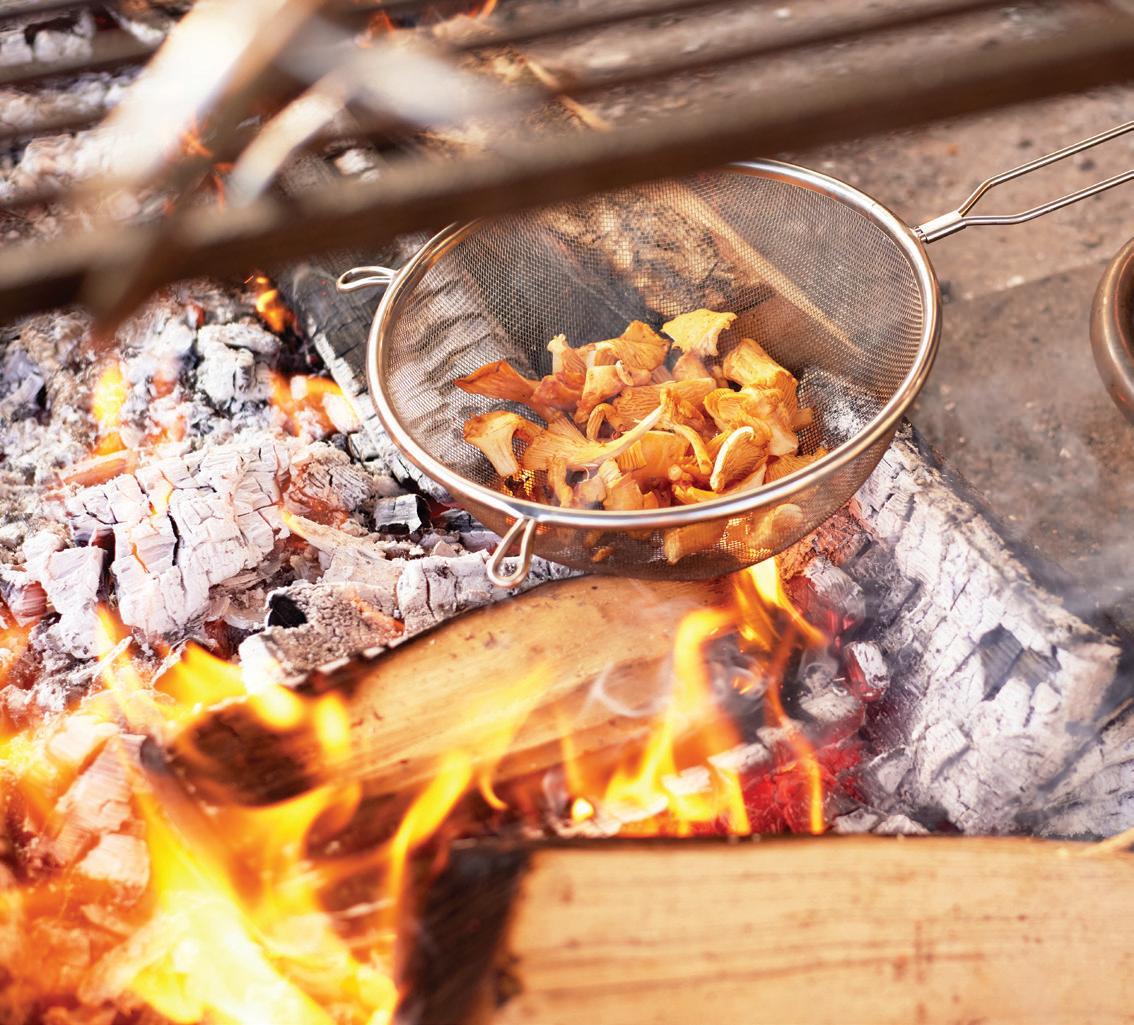





6 1 2 3
Hit List The latest foodie news and events for your calendar
The
1 | COOK LIKE A PRO
If your new year's resolution involves sharpening your kitchen skills, check out The Coexist Community Kitchen's line‑up of cookery events in Bristol.
The non‑profit cookery school hosts a plethora of classes, while also creating connections between people. Events in early 2023 include Southern Thai with Fish on January 12, Pickling & Fermenting on February 2 and The Sweet Spot on February 16.
2 | JUNK-FOOD FIX
Secret junk‑food fan? Head to Eight Stony Street in Frome on January 19 for its Junk Food and Wine tasting event. The wine bar and bottle shop in Somerset has created a three‑course menu for the event, which promises guilty pleasures such as hot dogs, scampi and doughnuts – each paired with a top‑notch wine. Tickets cost £50.
3 | GARDEN GATHERING
Make your way to Tisbury in Wiltshire on January 21 for a unique dining experience at Pythouse Kitchen Garden
The three‑course seasonal supper will combine ingredients from Pythouse's garden with produce from local suppliers. Expect dishes like butternut squash terrine with smoked wild mushrooms and January King cabbage.
Make the most of the wine included with supper by staying the night in one of the luxe shepherd's huts. Tickets cost £75.
4 |
MOORLAND FEASTING
Exmoor Food Fest kicks off on January 25 with a launch dinner at The Farmers Arms in Combe Florey, Somerset.
Then, from February 1, you'll have the opportunity to eat your way across Exmoor (and surrounding areas) as restaurants take part in the annual event. Participating venues, including The Kings Arms in Georgeham, The Seacliff Restaurant at Sandy Cove Hotel in Berrynarbor, Croydon Hall Hotel & Restaurant in Rodhuish and La Petite Bouchée in Witheridge, will offer set menus at excellent prices throughout the month.
Follow Exmoor Food Fest on social for news on additional tasting dinners and foodie events.
5 | HARBOURSIDE SUPPER CLUB
Attention, foodies: there's a new supper club in St Mawes, Cornwall. The Idle Rocks' monthly event promises an evening of gastronomic thrills at its waterside restaurant.
Join the club on January 26 or February 23 to enjoy drinks on arrival, a three‑course dinner crafted from the finest local produce, coffee and petits fours. Tickets cost £55.
6 | POLYTUNNEL SUPPING
Round up the gang for a unique kitchen‑garden dining experience in the polytunnel of Padstow Kitchen Garden on January 29.
The four course, zero mile feast will be cooked over fire using ingredients from the Cornish farm. The experience includes a welcome drink from Tarquin's Gin, and guests are welcome to take their own bottle for the main feast. Tickets cost £60.
7
|
JEFFREY ROBINSON TO HEAD UP NEW CORNISH RESTAURANT
Chef Jeffrey Robinson, formerly of The New Yard Restaurant and The Pantry in Cornwall, has announced he will take on the role of exec head chef at new dining destination harbourhouse in Flushing, Cornwall.
The restaurant is due to open in early 2023. Expect hyper local and sustainable dishes from one of the first chefs in the country to receive a Michelin Green Star.
7 / THE HIT LIST
Regeneration



nation


Regenerative farming is the latest buzzword in food and sustainability, but what does it mean and why do you need to know about it?

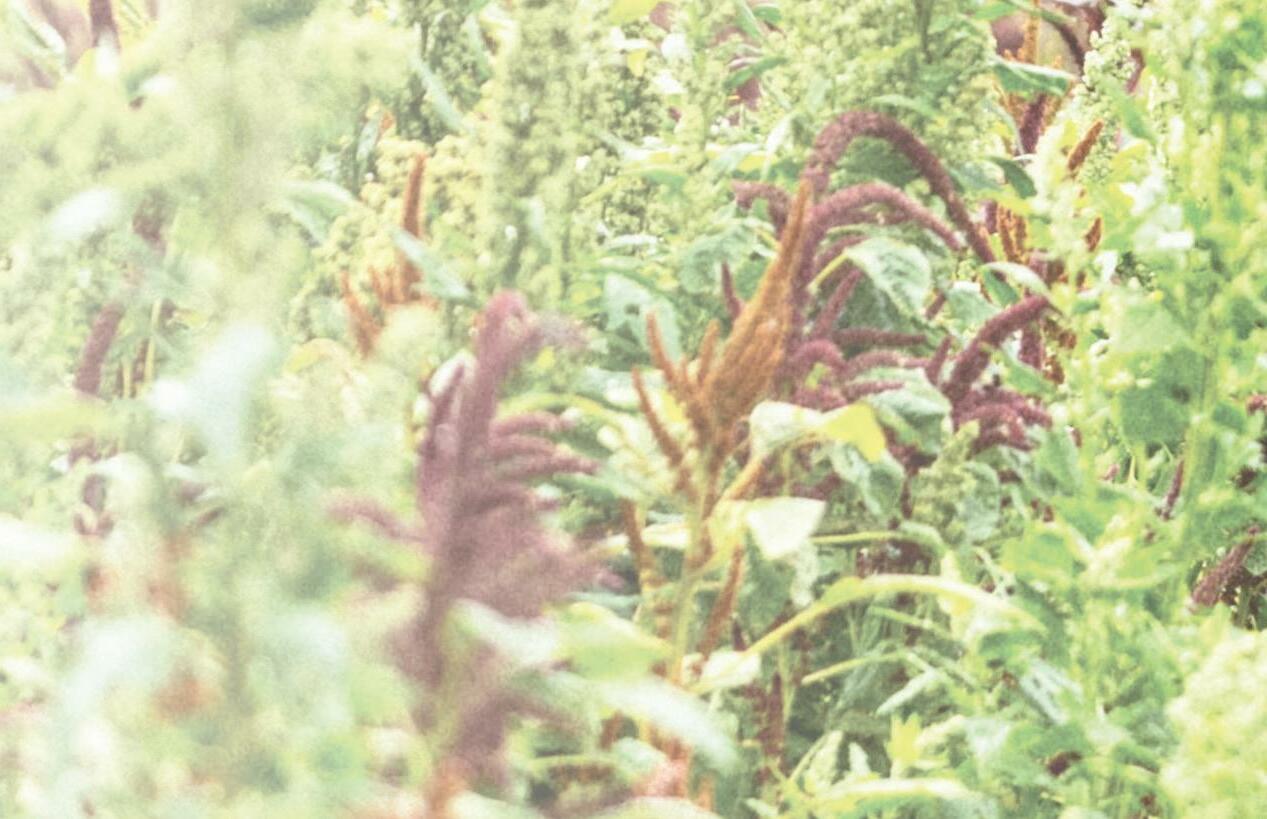



Kathryn Lewis asks a few regenerative changemakers

A BRIEF HISTORY OF BRITISH FARMING
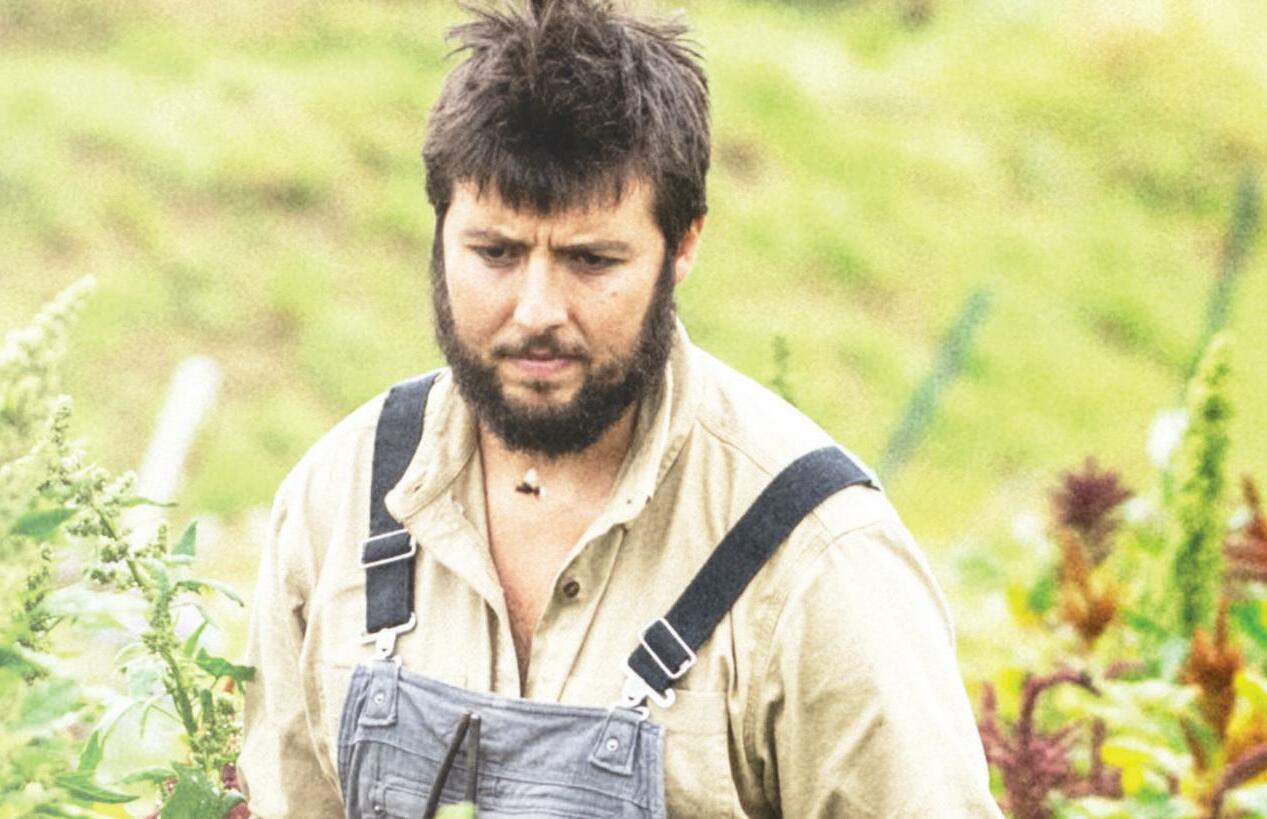
1870–1930 Although the UK produced much of its food using traditional organic methods, the development of steamships and trains led to the county importing more (and cheaper) food such as grain from the United States and Canada, and lamb from New Zealand. Self‑sufficiency gradually reduced as a result.

8 / ISSUE 194
Josh Sparkes, head gardener at The Collective at Woolsery
There are alarming predictions that our soils have just 60 harvests left before they become too barren to bear food – the estimate dwindling to nine fertile harvests in some parts of the world. Whether that's accurate or not (it's disputed in some quarters), it's rooted in the uncomfortable idea that the process by which much food is cultivated erodes the soil and exhausts it of nutrients.
Soil health is directly linked to climate change as soil is one of the planet's great carbon stores – as soil declines so does the amount of carbon it can absorb. As a result, soil health is becoming an increasingly pressing issue as the effects of climate change become more apparent. Some thought leaders believe there is a cure for soil's maladies: regenerative farming. It can be highly effective and, unlike many other green technologies, making the switch doesn't need to cost a fortune.
Shane Holland, executive chair of Slow Food in the UK, describes regenerative farming as: ‘a holistic approach to farming that focuses on how the farm and ecological systems come together’.

It's a way of farming that works in harmony with nature to replenish the soil and allows the ecosystems within it to thrive. Shane says: ‘It's farming in a way that people would have done before the second world war, where a variety of crops and animals are grown side by side.’
1930s Domestic self sufficiency was at just a third of the nation's requirements. The impending second world war saw the government increase grants for wheat production in order to feed a nation in wartime.
1945 Ships that would have been used for food importation were needed for military purposes, so the nation was persuaded to eat less via rationing, to ‘dig for victory’ and to keep chickens and pigs. Land Girls and prisoners of war took on the farming jobs of the men who went to fight.
9 / REGENERATION NATION
THE FOUR PILLARS OF REGENERATIVE AGRICULTURE

Regenerative farming isn't prescriptive. There are no set rules and currently there's no certification. However, four principles are generally followed: not disturbing the soil which means no (or very little) tilling, ploughing or digging; no (or low) use of fertiliser; growing a biodiverse range of crops and using cover crops; and the introduction of livestock on arable farms to create mixed farming (which fertilises the soil through the production of manure).
Diversity is key to building healthy and microbe rich soil. Sprawling fields of monocrops can deplete the soil of available nutrients and, although regular farming usually involves rotating crops, in regenerative farming an array of crops are grown in the same soil at the same time. Farming in this way and with the addition of cover crops (plants that aren't harvested but instead planted to protect the soil from erosion and to put nutrients back into the ground) is believed to increase microbial diversity, which means better soil health. Add animals to the mix and biodiversity is increased yet further.
It's not just the soil that benefits from a nutritional boost either: ‘Food grown following regenerative agriculture principles tends to have higher nutritional content,’ says Shane.
‘This isn't just because the soil is more nutrient dense,’ he asserts. ‘When attacked by insects, plants produce chemicals that protect themselves and alert other plants to the danger. These chemicals are called polyphenols and they're known for their health benefits for humans. If you spray plants with insecticides, it prevents that natural chemical reaction from occurring.’
This minimal input approach may sound simple, but for the past 75 years the South West's rich farming culture has been driven by the need to achieve high yields in order to remain financially viable. Farmers rely on fertiliser, animal feed and fuel to produce a harvest that's as reliable as possible so they can earn a steady income and produce food to feed the nation.
In many ways, regenerative farming is the antithesis of this: it's a process of trial and error which allows nature to call the shots. For most farmers, who operate on very tight margins, giving control back to nature is just too much of a financial risk.
THAT WORKS IN HARMONY WITH NATURE TO REPLENISH THE SOIL’
1947 In huge financial deficit after the war, the government decided the cheapest way to feed people was to encourage further self sufficiency and introduced the 1947 Agriculture Act. This subsidised farmers so they were able to invest in machinery. The subsequent increase in mechanisation, along with the wider use of fertilisers and pesticides, doubled the UK's agricultural output.
1962 Environmental conservation began in a quiet way with the publication of Silent Spring by Rachel Carson, which questioned the use of pesticides. It was followed in 1964 by Ruth Harrison's Animal Machines, which criticised intensive poultry and livestock farming.
10 / ISSUE 194
‘FARMING
REGEN IN ACTION
Josh Sparkes, head gardener at The Collective at Woolsery in north Devon, is one of the South West farmers going against the grain. The Collective, which includes a dining pub (The Farmers Arms), village store, accommodation, and fish and chip shop, is owned by multimillionaire couple Michael and Xochi Birch. The pair have the means and the desire to do something groundbreaking and the entire project is built around Birch Farm, its 150‑acre farm where Josh and livestock manager Chris Jenn employ a minimum‑input ethos to produce food for the project.
‘We want to grow food as sustainably and as cheaply as possible so we can produce affordable food for our community,’ explains Josh. ‘We strive to have no inputs from outside of the farm and to build fertility from what we have available.
‘We grow food as part of our ecosystem. Our approach is a mix of Japanese natural farming [Josh was awarded a fellowship that enabled him to train in Japan], agroforestry and permaculture.’


At the heart of the gardens and fields of Birch Farm is the use of polyculture, which sees multiple plants grown in the same place simultaneously. At the farm, around five plants coexist in the ground at any one time and, going against every gardener's natural impulse, weeds are allowed to live alongside to further restore soil health. But can this hands‑off way of farming be fruitful?
‘I've found it to be a slower but more relaxed approach,’ says Josh. ‘Once the crops get going, we don't have to do much: we don't have to weed as the crops naturally outcompete them, we don't have to irrigate as moisture is kept within the ground and we don't have to constantly hoe the soil. It's going incredibly well – the hardest thing is resetting your attitude.’


On whether he thinks more farms in the South West will follow suit, he says: ‘Farming has to go this way as the cost of fossil fuels and fertilisers are spiralling and conventional farming is becoming unaffordable. The only way the land can be regenerated is via nature –humans can't do it – so we've got to give nature space to heal itself.’
1973 The UK joined the EU and was bound by its agricultural policy of importing mostly from the five other member states. British farmers stopped getting their subsidy payments but benefitted from much higher market prices, so the industry became highly profitable. Farmers responded by producing even more food so that by the early 1980s the UK had reached self‑sufficiency levels of 75 per cent.
1984 The EU policy of encouraging farmers to produce more and more food became too expensive and so milk quotas were introduced.
‘THE ONLY WAY LAND CAN BE REGENERATED IS VIA NATURE –HUMANS CAN'T DO IT’
11 / REGENERATION NATION
POWER IN FLOUR
Birch Farm isn't alone in the South West in its regenerative endeavours. Another group of farmers using regenerative practices are working with Wildfarmed, a flour producer that provides a market for the farmers' harvested grains. Its Growers Community currently has over 40 members across the UK and France, and their grain is milled at Matthew Millers in the Cotswolds.
‘Wildfarmed was born out of a desire to incentivise farmers to farm regeneratively, but at a scale where they could sell to the high street,’ says Harriet Cherry, agricultural relationship manager at Wildfarmed.

‘Current farming systems focus on yield and volume. We've created an opportunity for conventional farmers to take a first step into regenerative agriculture in a way that comes with support. And we offer a financial premium which alleviates the risk of dropping out of the conventional system.’


Wildfarmed isn't prescriptive about what constitutes regenerative farming. Instead, the team aim to empower farmers to understand their soil – they know that what works for a farmer in Devon might not work in Northumberland. However, they do have two non‑ negotiables: no herbicides, pesticides or fungicides are to be used once the seed is in the ground, and multiple plants must be planted in the soil at the same time.
‘We're approached by farmers of every stripe who want to join our network,’ says Harriet, who describes working with relatively new farmers as well as those who have farmed conventionally for years before switching lanes. ‘As well as producing a route to market, we provide a community space where farmers can share knowledge.’
Wildfarmed is still in its infancy (it launched in 2018), but the company has undertaken baseline data collection and will monitor the health of the soil on selected farms over the next five years to quantify the effects of regenerative farming.
The organic movement began to gain traction. Farmers saw opportunities to use less chemicals as well as the chance to produce less food and sell it at a higher price.
Late 1980s
1990s The EU changed its agricultural policy and began paying farmers simply for being farmers via the Single Farm Payment (SFP).

12 / ISSUE 194
‘WHAT WORKS FOR A FARMER IN DEVON MIGHT NOT WORK IN NORTHUMBERLAND’
CONSUMER CLOUT

While there is currently no certification for regenerative farming in the same way there is for organic farming, there are still ways in which consumers can support farmers' use of regenerative agricultural practices. Shane of Slow Food recommends shopping at farmers' markets, farm shops and independent butchers where you can ask how and where the food was grown or reared.

It's worth remembering that consumers can be very powerful because retailers tend (eventually) to adapt to customer demand. Harriet says: ‘Regenerative farming is a direction of travel rather than an absolute state of being’. And so, as consumers, we can ask questions and make associated purchasing decisions to help ensure it heads the way we'd like it to go.
2020 Brexit left the UK government looking for something to replace the SFP. Lack of precise detail about what this replacement will look like has left farmers unsure about the future.


‘REGENERATIVE FARMING IS A DIRECTION OF TRAVEL RATHER THAN AN ABSOLUTE STATE OF BEING’
13 / REGENERATION NATION
Thanks to agricultural historian Paul Brassley for his help with this timeline.
BREAKING NEW GROUND
Another South West business that's embracing regenerative farming is Cornish dairy Trewithen

14 / ISSUE 194
The Trewithen team work with 35 farms, all within 25 miles of the dairy, to produce 100 per cent Cornish milk, which they also craft into clotted cream, butter and yogurt. The Clarke family, who own Trewithen, have been dairy farming for generations, but have been interested in the rising tide of regenerative farming for over a decade. Always a company to take a measured, scientific approach, the Clarkes hired a leading agricultural advisory company to help when they decided to work towards a regeneratively farmed future.
To pilot the Earth Milk Project, two of Trewithen's contracted farms agreed to adopt regenerative agriculture methods and for more than two years the soil content and fertility of every field on these holdings has been monitored by experts. All of the findings are regularly shared with Trewithen's wider farm pool so they can apply the lessons to their land too. The results are proving extremely promising and Trewithen is now investing further in natural land management as it looks to support more farms in joining the project.
HOW SOIL HELPS CAPTURE CARBON
SOIL COVER
Cover crops are used to help protect the soil from erosion by wind, water and water loss.
DITCHING DEEP PLOUGHING
Leaving the soil alone to manage itself improves soil structure, drainage and water holding capacity.
DIVERSE CROPPING
Farmers select a mix of perennials that not only feed cows the perfect blend of nutrients, but also nourish the soil. Francis Clarke, director at Trewithen Dairy, says: ‘A biologically active soil can be much more productive than one reliant on chemicals. Each one per cent of increased organic matter in the soil helps retain gallons more water per acre. And increased water-holding capability means less nutrient run-off, greater carbon capture, resilient crops and improved soil structure.’
LIVESTOCK INTEGRATION
Cows deliver essential ecosystem services that help restore nature; through a managed grazing rotation, cows actually improve the quality of the soil. Allowing the pasture time to rest between grazing gives the grass's roots ample time to recover and grow deeper and stronger.
BOUN TIFUL BENEFITS
It's not just the soil that benefits – there's a noticeable increase in wildlife too. Worms, bees and butterflies are good markers for happy soil and productive land.
As regenerative agriculture calls for less intervention, it encourages an environment for insects and other creatures, which are tiny helpers for farmers. Earthworms, for one, burrow through the soil, munching as they go, gently churning up the earth. This moves nutrients around and creates channels for root growth, which helps increase the soil's water holding capacity.
‘We are very excited about the positive results obtained so far, but we believe in being measured when it comes to making claims publicly,’ says Francis.
‘Farming means working with nature, and natural conditions can fluctuate enormously. Until we get to the point of sharing our results, we remain extremely positive about taking a regenerative approach to milk production.’
trewithendairy.co.uk
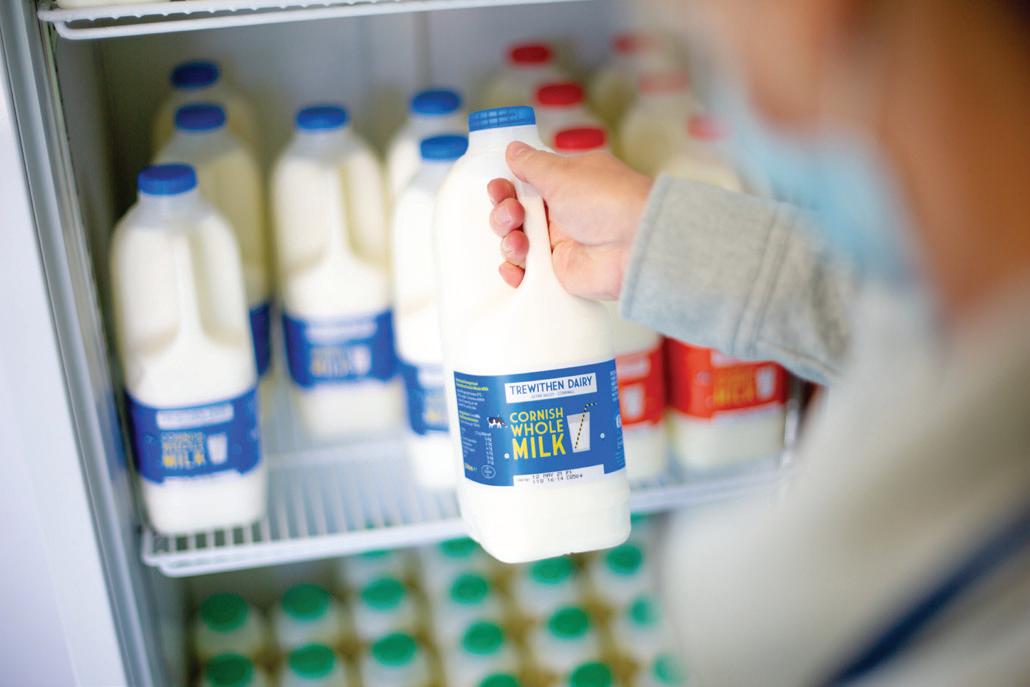
15 / SUPPORTED CONTENT
Staycation guide
England's smallest city has plenty to offer visiting foodies, as well as those making the trip to tour its grand cathedral and medieval palace. Kathryn Lewis reveals the best places to eat, drink, stay and shop

Wells
16 / ISSUE 194
Where to stay
If your ideal place to spend a night is an ancient pub with good food and fine ales downstairs and cosy rooms with crooked ceilings and wonky floors upstairs, you're in luck: Wells is full of them.
Established in 1450, The Crown at Wells is one such inn that offers contemporary lodgings in a historic setting. There are 15 ensuite bedrooms above the ancient bar, four of which have four poster beds and views over Market Place. If you choose to eat in, there's a crowd pleasing pub menu (Wiltshire ham, egg and chips, chicken and leek pie with mash and greens, etc) alongside a more polished line up of dishes such as Somerset pork belly with apple sauce, crushed new potatoes and market veg.
Film fans might recognise The Crown's exterior from British comedy Hot Fuzz, which was filmed throughout the city and for which there are location tours available.
For over 600 years, The Swan Hotel has fed, watered and sheltered those who make the pilgrimage to worship at Wells Cathedral. Its clientele might have diversified in the last century, yet its warm welcome, comfy rooms and central position (right opposite the cathedral) still make it a popular spot for visitors.
The Swan's restaurant was one of just 30 to feature in the first UK Michelin Guide in 1911 and remains in the revered dining tome to this day. The kitchen team strive to source as much as possible from within 25 miles, so overnight guests can expect to tuck into a locally sourced brekkie before a day of exploring.
Those seeking a more refined rural experience will find it at Beryl Country House, just a mile from the city centre. The beautiful country pile was built in 1838 and remained a private residence until 1982 when its current owners opened it as a hotel to fund its restoration.

Beryl's six bedrooms are dressed in a classic country house style, some with four poster beds and views across the gardens to the cathedral. In summer, the outside pool is open and guests can take the opportunity to indulge in afternoon tea on the lawn.
 The Swan Hotel
The Swan Hotel
17 / STAYCATION GUIDE
Beryl Country House






















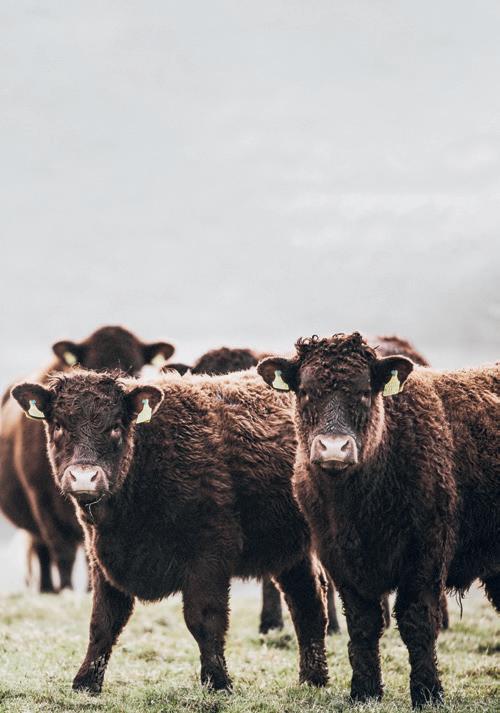





































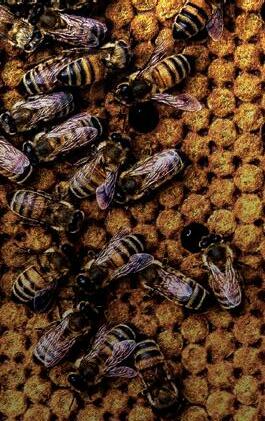































END GAME FOR THE INDIES? The spiralling costs of running a restaurant SOUTH WEST WINE COUNTRY Devon's vineyards Issue 190 May/June 2022 food-mag.co.uk FREE Where to eat, drink, stay and shop Weekend in Fowey read more at www.food-mag.co.uk May June 2021 Issue 184 £3.50 HIDDEN-GEM HOTELS Avoid the crowds this staycation season NEXT-GEN BAKERIES The new indies changing bread for the better WEEKEND COOKING Time to fire up the barbie Meet the women revolutionising British barbecue 'CUE QUEENS Issue 188 January/February 2022 Read more at food-mag.co.uk FREE Take me home SHOULD MEAT BE OFF THE MENU? read more at www.food-mag.co.uk April 2021 Issue 183 £3.50 WHERE SOLD LUCKY SEVEN The G7 gang's itineraries, sorted EMILY SCOTT FOOD Cornwall's most talked-about new restaurant TAKEOUT REVOLUTION A new dawn for dining? Where to eat, drink and stay in Lyme Regis STAYCATION SEASON Food MarApr 2021 Cover.indd 4 18/03/2021 10:39:06 September/October 2021 THE SOUTH WEST'S MOST SUSTAINABLE FOODS PAUL AINSWORTH Predicting a regional culinary revolution TRENCHERMAN'S COUNTRY Discover this season's great escapes STAYCATION GUIDE Where to eat, shop and stay in Dartmouth www.food-mag.co.uk FREE www.food-mag.co.uk MICHAEL CAINES On the future of food and drink WEEKEND COOKING Recipes worth staying in for AGAINST THE ODDS 2020's unlikely restaurant openings November December 2020 COCKTAIL LOUNGE 2.0 LOCKED DOWN AND LOADED £3.50 21/10/2020 16:48:04 FORAGE LIKE A PRO Make the most of the wild food on your doorstep WEEKEND COOKING Easter Sunday, sorted STAYCATION GUIDE Where to eat, shop and stay in Clifton Issue 189 March/April 2022 Read more at food-mag.co.uk FREE Take me home Lifting the lid on the world of honey Issue 192 September/October 2022 Read more at food-mag.co.uk FREE Take me home TO B OR NOT TO B What is a B Corp and why should you care? MATT MASON On his career-changing move to Winslade Manor STAYCATION GUIDE Where to eat, shop and stay in Frome The murky world of sourfaux COUNTERFEIT CARBS Food SepOct 22 Cover.indd 4 18/08/2022 14:26 Issue 191 July/August 2022 Read more at food-mag.co.uk FREE Take me home FOOD READER AWARDS Meet your 2022 winners VEG REVOLUTION A new era of barbecue STAYCATION GUIDE Where to eat, shop and stay in Bude 5 OF THE BEST ARTISAN ICE CREAMS BABY ICE ICE Food JulAug 22 Cover.indd Become a Food Magazine subscriber and get every new issue delivered to your door for just £25 (6 issues) food‑mag.co.uk/subscribe Treat yourself to a whole year of
Where to eat
New restaurant on the block Root should rank highly on your list of dining destinations in Wells. A sister site to the restaurant of the same name on Bristol's Wapping Wharf, this is the kind of place to meet like‑minded friends who appreciate great food and warm hospitality.
Chef owner Rob Howell describes the offering as: ‘modern, veg-led sharing plates’. Local, seasonal and sustainable ingredients take the starring role in dishes such as carrots with sobrasada butter and seared dukkah, and baked Cornish hake with warm cod's roe and fennel salad. The neighbourhood restaurant only opened in December 2022 but, if the original is anything to go by, it'll be a hit.
From newbie to established go‑to, Goodfellows @7B has been a pillar of the Wells food and drink scene for over 15 years. The restaurant, run by Adam and Martine Fellows, recently relocated to a new venue on St Thomas Street and reshuffled its opening times (Thursdays to Saturdays).

Visit for Mediterranean dishes crafted with British ingredients. Classics such as bouillabaisse and crab croquettes are elevated with complex sauces and on‑point presentation. If you're keen to uncover head chef Adam's culinary secrets, join one of his cooking courses which are held regularly at the restaurant.
For an edible slice of Athenian sunshine in the depths of winter, book a table at The Greek Taverna on Union Street. Authentic small plates, salads, and fresh meat and fish cooked on the grill feature on a lengthy menu which also includes less familiar regional specials. Ask a local for their lunch recommendation and there's a good chance you'll be directed to The Good Earth on Priory Road. Part restaurant, part homeware shop, part wholefood store, the Wells institution has been feeding locals and visitors for 40 years.
The informal spot serves the kind of wholesome fodder we all crave when it's blowing a gale outside. The daily bill of veggie dishes are scribbled on the blackboard and feature the likes of vegetable dhansak; mushroom, brie and thyme quiche; and roasted vegetable pizza with tomato, beetroot and feta.
Just a 15‑minute drive from Wells is Queen of Cups in Glastonbury. As you're in the area it would be a huge mistake not to sample Ayesha Kalaji's Jordanian‑Welsh fusion food. Read all about it on page 28.

19 / STAYCATION GUIDE
Root Queen of Cups


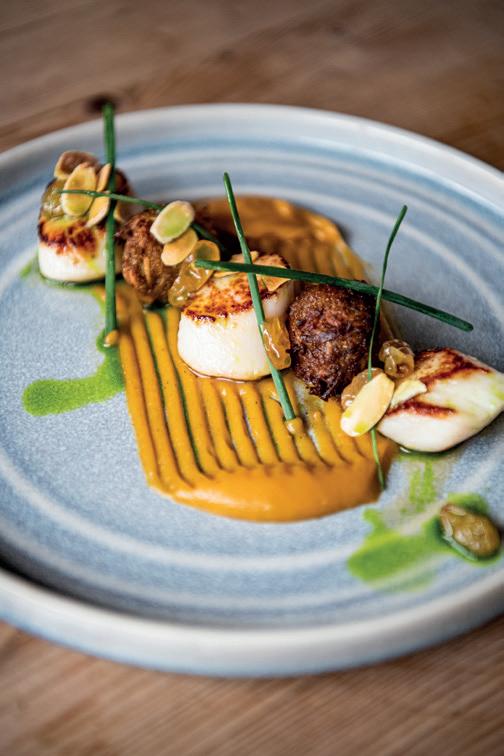

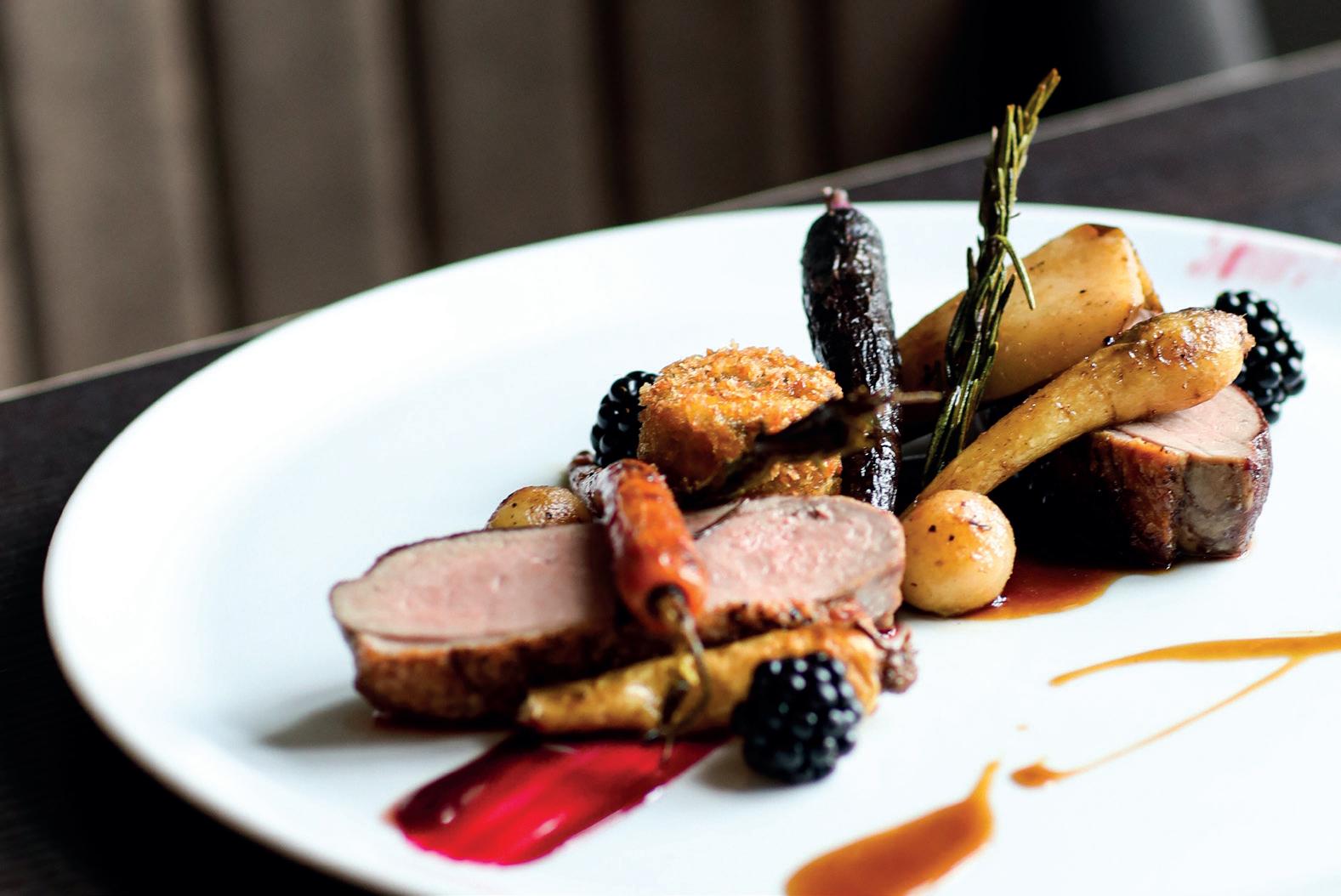




20 / ISSUE 194
Blackdown Hills' best-kept secret A short foodie break in the countryside where you’ll wake up to the sound of bleating sheep and bird song. Enjoy home-grown restaurant food in a warm and welcoming setting The Cotley Inn, Wambrook, Somerset, TA20 3EN 01460 62348 cotleyinnwambrook.co.uk countryside sound of song. Enjoy a warm welcoming setting disJanuary and make instead of Use code FOODMAG23 for 10% discount on B&B bookings in January and February. Top notch tipples, relaxed fine dining and a warm Cornish welcome. Dine with us this season. THEALVERTON.CO.UK stay@thealverton.co.uk | 01872 276 633 A luxury four star silver hotel in the city TREGOLLS ROAD TRURO CORNWALL
The
Bishop's Eye
Where to drink
Wells has a thriving caffeine community and Strangers with Coffee on St Cuthbert Street is your go to for a top tier selection of beans. The tiny shop punches above its weight in terms of quality; we recommend kicking off with a flat white and then taking it next level with a hand poured V60.

A good coffee is also guaranteed within the fluorescent setting of LOAF on Market Street. The brightly decorated bakehouse's coffee blend is a mix of Peruvian and Ethiopian beans, which is delicious on its own and even better paired with silky steamed milk. Buddy up your coffee choice with a glorious bake from the counter (the cinnamon bun with lashings of salted caramel sauce between its pillowy layers is outrageously good) or set yourself up for the day with your pick of the brunch menu.
Round off a walk around The Bishop's Palace and Gardens with a glass of wine at Bishop's Eye. The wine bar and eatery is set within the Grade II listed gatehouse of the palace, but has been thoroughly modernised to create an art deco inspired space which showcases a curated selection of wines from around the world.
Another good call for drops by the glass is Santé Wines in Heritage Courtyard. The wine and coffee house is run by David Schroetter (who grew up in the Loire Valley) and is a lovely place to sample wines before buying a bottle or two to take home.
Where to shop
There are further opportunities to pick up interesting bottles at The Grape & The Good on Broad Street. Pop in to browse a hefty selection of old and new world wines, plus a collection of craft beers.
If you require some snacks to balance out the booze, cross the road to Queen Street Deli, a treasure trove of local cheeses, charcuterie, crisps, chocolates and more. There are also takeaway treats such as fresh focaccia stuffed with finocchiona salami, buffalo mozzarella and fig chutney, and taleggio, pepper and red pesto tarts.
For sweet mementos of your time in Wells, pick up a couple of bejewelled slabs from Flapjackery on Sadler Street. The mammoth slices of Devon made flapjack are infused with flavours which run from peanut butter brownie to lemon drizzle.

Flapjackery 21 / STAYCATION GUIDE
Winter of content
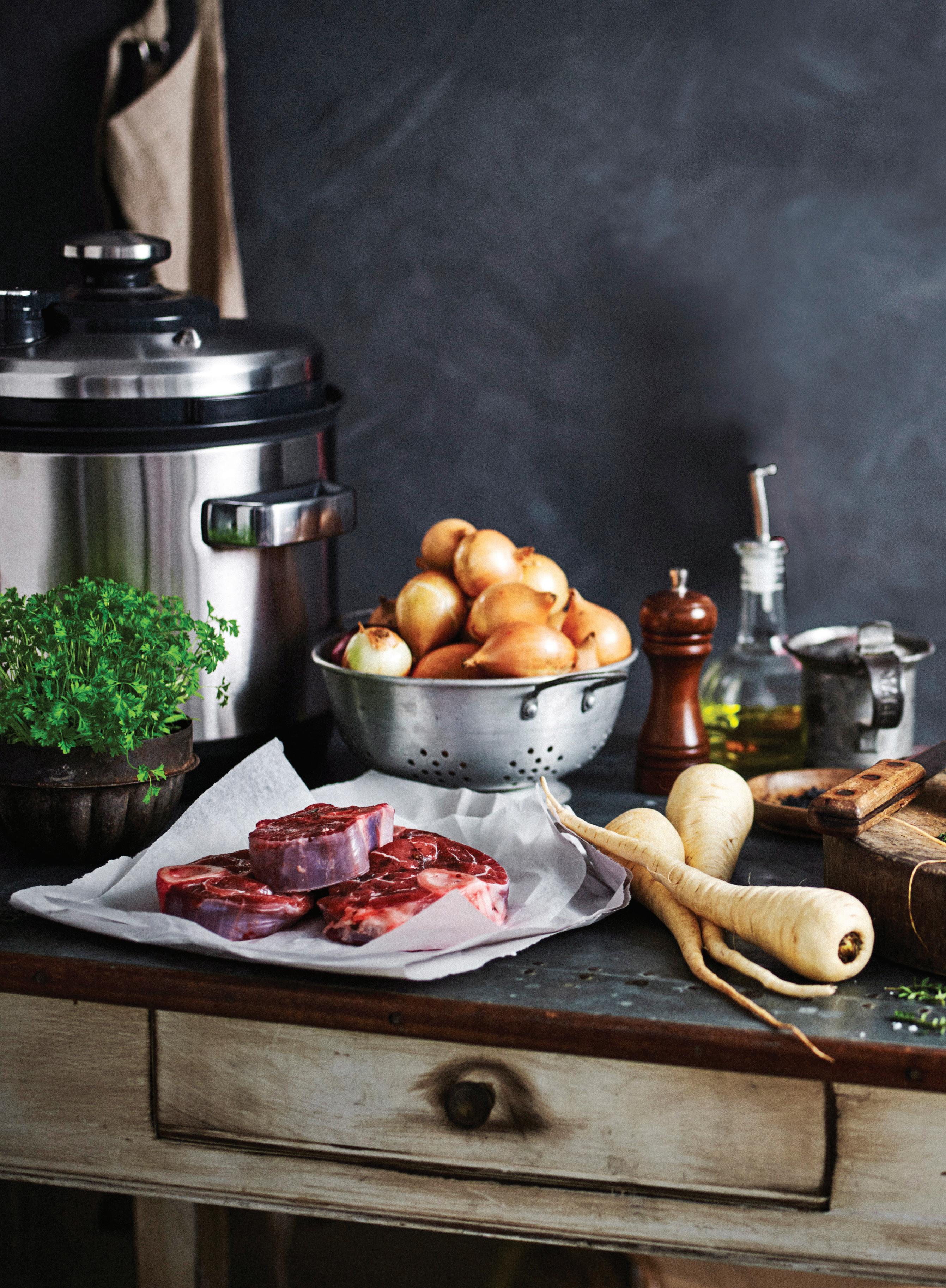 Jo Rees and Mel Stewart take comfort in that stalwart of the 1970s: the slow cooker
Jo Rees and Mel Stewart take comfort in that stalwart of the 1970s: the slow cooker
22 / ISSUE 194
The ‘winter of discontent’ of 1978/79 was a stew of industrial action, stagflation and an energy crisis, when bin bags were piled high on the streets and NHS ancillary workers blockaded hospital entrances.
If anything rivals the post Covid meets cost of living crisis in which we currently find ourselves, it was that period. Yet those of us old enough to have lived through the late 70s got through the candlelit evenings when the power was off, and eventually the rubbish was collected. So what can we take from those days to help us through these challenging times? Step forward, slow cooker, you comforting stalwart of the 1970s.
It's no wonder the slow cooker is enjoying another moment: it meets contemporary cooks' desire to cut energy use, thrives on cheap ingredients and delivers fuss free comfort food after a long day at work. If you're not yet on board with the joys of the slow cooker, let us reveal why it should be your latest obsession.

23 / WINTER OF CONTENT
Kitchen introvert
Slow cookers are the least demanding of all kitchen gadgets. The introvert of the kitchen, they're happy to be left alone for hours at a time. Unlike more needy pieces of equipment, they don't like to be fussed over and actually require an extra 20 minutes of cooking every time you lift the lid, so the rule is: hands off!
Don't worry about overcooking, either: if you're using the low setting, an extra hour or two won't make much difference.

Flavour forward
Cooking low and slow reveals layers of flavour that otherwise remain locked away, developing sweet and rich umami notes of vegetables and breaking down the connective tissue in cheap meat cuts. Hunks of brisket, which would be grindingly tough roasted, are transformed into yielding ribbons of tender meat. Cooking on a low heat also retains the integrity of the ingredients' nutrients.
Energy lite
Uswitch's energy efficiency guide names slow cookers as one of the kitchen's most energy efficient appliances. It states: ‘Although they take longer to cook food, they're rated at as little as 200 watts –less than a tenth of some electric ovens. An average-sized slow cooker uses just 1.3 kWh per meal cooked, which, when broken down to an hourly cost, comes in at under 1p on the average energy tariff.’ And if you've got solar panels you can reduce this further by using your slow cooker during the day, ready for your supper.
‘Cooking low and slow develops the sweet and rich umami notes of vegetables and breaks down the connective tissue in cheaper meat cuts’
24 / ISSUE 194
Need to know
Setting savvy
Low and high settings on slow cookers don't reference the temperature at which the food is cooked, instead it's the time it takes for the food to reach a simmer. On a low setting it takes longer, so the food cooks for longer at a lower temperature. Once the food is simmering, the slow cooker stabilises and continues to cook at that temperature.
The low setting is ideal for tougher cuts of meat which need time to break down. Lean cuts of meat and chicken often cook better on high to avoid them drying out and overcooking. The warm setting isn't for cooking, it just keeps the food warm until ready to serve.
Reducing sauces
One of the downsides of slow cooking is that sauces don't reduce because the water that evaporates from the food condenses on the lid and drips back into the pot. Often that means having to place the pot back on the hob to reduce the sauce at the end, or removing and discarding excess liquid.

Try putting a tea towel over the top of the slow cooker before replacing the lid. This absorbs the excess moisture, thickening the dish and deepening its flavours. The cloth can be replaced with a fresh one when needed, but usually one tea towel during the final couple of hours will do the trick. Alternatively, you can cook the dish for an extra couple of hours with the lid off or add flour or cornflour to thicken the sauce.
Bite size
Think about the cooking time of the various ingredients you are using in your dish. For example, root veg like potatoes and carrots need longer to cook than peppers and courgettes, so if you are using them in the same dish, the latter will end up overcooked.
Deal with this by either cutting ingredients like carrots and potatoes into smaller pieces than the soft vegetables, or by cutting everything the same size and giving tougher veggies a head start.
Sauté sizzle
Meat and vegetables like onions are immeasurably better after they've benefitted from the Maillard reaction – the chemical reaction between amino acids and sugars that gives browned foods their sweet umami flavours. Some pots have a sauté setting, so you can sauté ingredients in the pan with the lid off before covering and turning on slow cook mode. Others have a removable pot, which can be put on the hob to do this browning before being put back into the slow cooker case.
25 / WINTER OF CONTENT
Kit guide
Not all slow cookers are created equal. Generally, the more you pay, the more functionality the slow cooker will have – but more expensive doesn't necessarily mean better.
Manual slow cooker
If you're new to slow cooking, you can't go wrong with a basic version which consists of a casserole dish with a glass lid that sits inside a heating element which you plug into the mains. On the front there'll be a manual knob which can be adjusted to low, medium or high (and sometimes warm). Prices start at £15.
Digital slow cooker
This works in the same way as a manual slow cooker but with a few more bells and whistles. Usually it will have an in built timer, so that once the slow cooking time is reached the appliance will automatically turn off or switch to warm. This is handy if you're out all day. Some modern slow cookers are wifi enabled too, so you can adjust the cooking time and temperature remotely from an app.
Multi-cooker
Much more than a slow cooker, a multi cooker can carry out lots of different functions, such as pressure cook, sous vide, sauté, steam, roast and simmer. This reduces the need to have multiple appliances in the kitchen and can help save money as they tend to use less energy than conventional cookers and ovens. However, slow cookers with multiple functions have a higher price tag: expect to pay upwards of £100.
26 / ISSUE 194
Magazine



‘Host a Mexican night with slow-cooked chipotle pulled pork or beef brisket tacos served with homemade coleslaw, guacamole and pickles’



‘It may sound like overkill, but I have not one but three slow cookers: a small Crockpot for day-to-day use and two six-litre slow cookers I bring out when I'm entertaining at home. Whether I'm inviting friends for dinner or hosting a party, slow cooking is the easiest and most stress-free way to cater.
‘Firstly, you can fire them up early in the day and leave them to simmer away while you frantically tidy the house, walk the dog and get organised. Then, there's the fact that when your friends do arrive you don't have to spend the first half of the evening slaving (and sweating) in the kitchen. You can prep a cocktail, mingle and know that the food is staying warm until you're ready to dish it up.
‘The other fantastic thing about slow cooking is its versatility. Host a Mexican night with slowcooked chipotle pulled pork or beef brisket tacos served with homemade coleslaw, guacamole and pickles (prepped the night before and stored in the fridge). Or feed a crowd with a curry. If I'm hosting a party, rather than faff with a buffet, I tend to slow cook two different curries, like a chicken tikka masala and a lamb rogan josh. You can even cook rice in the slow cooker too.
‘While the finished product might lack the polish of a perfectly plated steak, you can still create delicious dishes packed with flavour. Indeed, I've lost track of the times I've been asked for the recipe for my slow-cooked venison in redcurrant jelly.
‘For me, slow cooking is the ultimate way to entertain because it allows you to serve beautifully cooked food while at the same time being completely present and sociable; it's a win-win.’





Food
journalist Mel Stewart is a big fan of using her slow cookers when entertaining a crowd and says:
27 / WINTER OF CONTENT
REVIEWS


28 / ISSUE 194
Queen of Cups
This Middle Eastern restaurant within a historic Glastonbury pub was only established 18 months ago, yet it's already received a nod from Michelin and a flurry of national awards, discovers Kathryn Lewis
10-12 Northload Street, Glastonbury, Somerset, BA6 9JJ
WHAT'S THE DRAW?
Named after a tarot card that depicts a woman sitting on a throne with a chalice in hand, Queen of Cups is a fitting moniker for a restaurant run by two ambitious females who share a predilection for fine wines. When revealed on the tarot table, the card indicates ‘nurturing mother energy’, which is something chef owner Ayesha Kalaji and co‑owner Mary‑Elizabeth O'Neill certainly channel at their inclusive restaurant, although in this case it's through welcoming hospitality and soul‑nourishing food and drink.
Whether you're a divination disciple or a supernatural sceptic, you'll be thankful for whatever higher power led you to Queen of Cups' dining room. Unshackle yourself from life's stresses and formalities and lean into good times with friends over fabulous food.
Visit in the daytime to indulge in a lazy lunch of small plates, breads and dips with a couple of glasses of wine, or take a crowd for a supper of sharing plates – plus more polished dishes which you'll want to keep to yourself. There are regular events such as LGBTQ+ nights too, which bolster the feeling that this is much more than a restaurant for the many tourists who pass through Somerset's famous town.
WHO'S COOKING?
Head chef Ayesha didn't plan a career in the kitchen. It was while studying for a degree in Middle Eastern politics that she was inspired to turn her interest in cooking into a job. After uni, she enrolled at Leiths Cookery School in London and from there refined her craft at some of the capital's best restaurants.
Drawing on both her Jordanian heritage and childhood in north Wales, her cooking is a unique blend of culinary cultures. Middle Eastern cuisine takes the lead, but there's French influence from her time at Leiths as well as snapshots of her Anglesey upbringing.
WHAT TO ORDER?
Control freaks take note: get out of the driver's seat and let the front of house team navigate. Unless you've grown up in a Middle Eastern household or travelled in the region, there'll be some unfamiliar items on the menu. But don't let that hold you back as some of the more obscure dishes are the most rewarding.
We started with Moroccan frena bread, scorched on the hibachi grill and topped with sea salt and a generous glug of olive oil. This was paired with a trio of dips: velveteen hummus doused in chilli oil and pine nuts; a sweet and spicy pumpkin, apricot and harissa dip bejewelled with pumpkin seeds and preserved lemon; and a suitably tart labneh finished with candied walnuts, fermented Syrian chilli and pomegranate seeds.
Next came warm laverbread falafel (the Welsh speciality added for moisture and colour) on a bed of creamy tahini sauce and shredded lime fennel. It was kept company by a plate of nabulsi cheese (halloumi's Palestinian cousin) bathing in a pool of local honey which was flecked, Jackson Pollock style, with dehydrated black Persian lemons which added a herbaceous, floral note. It was finished with a crown of finely diced preserved lemons to counterbalance the sweetness with bold acidity.
Our final dish was a diversion from the small sharing‑style plates we'd sampled so far. Built around a hearty fillet of monkfish which had been slow cooked in beef dripping to emphasise its meaty characteristics, the showstopping medley was finished with arak‑infused beurre nantais sauce, local wild mushrooms, pickled gooseberries and samphire.
FOOD'S TIP
Over order on the cold dishes and breads so you can take your leftovers home – the team have a stack of compostable containers on hand.
queenofcups.co.uk
29 / REVIEWS
Feverish
Sea Fever
for a winter seafood fix? A tide‑to‑table supper at this Bude restaurant is just the tonic, says Selena Young
17 Summerleaze Crescent, Bude, Cornwall, EX23 8HJ
WHAT'S THE DRAW?
Leave the restaurant bustle of Bude's Belle Vue and Queen Street for this unassuming cliffside venue which serves delectably fresh seafood.
Despite its picturesque location on Summerleaze Crescent, Sea Fever flies somewhat under the radar because of its setting within Atlantic House Hotel. However, don't let this deter you as it's a find for gourmets who get excited about menus that are built around the local catch.
The team at Sea Fever are so inspired by the big blue and its spoils that they named the restaurant after poet John Masefield's ode to the ocean.
WHO'S COOKING?
Bude‑born chef Kyan Hooper – who earnt his stripes in Yorkshire at Michelin‑starred restaurants Rascasse and The Star Inn at Harome – is well versed in cooking seafood. The head chef has strong family ties with the local fishing community, so only the freshest fish make it into his kitchen.
Kyan skilfully turns these high‑quality ingredients into comforting, crowd‑pleasing dishes typical of a traditional French bistro – with a dash of Asian influence for good measure.
WHAT TO ORDER?
It seems trivial to talk bread when the seafood was so good, but the warm malted loaf with its honeyed notes, caramelised crust and carpet of salty seaweed butter warrants a moment of reflection.
The moreish bread started the meal alongside tasty morsels such as smoked anchovies, and Porthilly oysters with pear and jalapeño. Snack sensibly, however, as you'll want to save room for starters like the tandoori mackerel with squid bhaji, pickled cucumber and coriander. The mackerel's spiced yogurt marinade permeated its delicate flesh with warming heat, providing a delicious contrast to its torched skin.
A second starter of buttermilk monkfish in a pool of sweet hot sauce with house pickles, crème fraîche and sliced red chillies also scored highly for creativity.
Choosing between mains of fish stew packed with mussels, hake, monkfish, gurnard, sea bass and smoked haddock, and the hake with pumpkin, vadouvan spice, yogurt and broccoli was tough work. The latter swung it and was a triumph of French‑Indian fusion cooking.
Following such fish‑heavy feasting you might be tempted to turn down dessert, but it's worth trying one of the homemade ice creams or sorbets if you've only a smidgen of room. The plum sorbet was lip‑smackingly good as a side to the lemon posset pud.
FOOD'S TIP
If you spy lobster on the menu, order it! It will have been caught in Bude Bay by Kyan's uncle.
sea-fever.co.uk
30 / ISSUE 194

31 / REVIEWS

32 / REVIEWS
Rise
West Bay, Dorset, DT6 4EZ
WHAT'S THE DRAW?
An informal riverside cafe bar, perched on its own mini island, where families can rock up for breakfast, brunch, lunch, supper or coffee in complete confidence that everyone will find something to satiate their appetite.
As casual eateries go, Rise has to be one of the most appealing in Dorset. In summer, you can sit outside and enjoy the riverside location protected from the sea breeze by a high glass balustrade. On a cosy winter evening, when rain lashes on the panes and the little footbridge that delivers you to the restaurant swings in a squall, it's a sheltered sanctuary in which to hunker down.
Its mix of wooden furniture, colourful throws and cushions, verdant plants and flickering candlelight creates a laid‑back hygge vibe, which encourages guests to relax and natter. The easy‑going feel is enhanced further by an open kitchen that brings the chefs' cooking right into the hubbub of the restaurant.
WHAT TO ORDER?
The kitchen team craft a mean burger and lavish each bun with extreme generosity. Served on Rise Bakery sesame seed brioche, each one is stuffed with delights such as buttermilk fried chicken, tempura local fish, and sweet potato and quinoa patty.
While it's hard to make a choice between these tempting fillings, the epic Dorset Longhorn is arguably the most succulent, juicy and flavoursome pick of the burger menu. Ours arrived heaped with grass‑fed chuck‑steak patty, smoked bacon, roasted onions, burnt‑butter mayo and lettuce, and drizzled with Dorset Blue Vinny.
WHO'S COOKING?
Richard Cooper and Nikki Craven have a stellar history in hospitality (former successes include The Bull Hotel in Bridport and The Stable family of pizza and cider restaurants). The couple, along with fellow The Stable colleagues Andy Briggs and Kyle Clark, opened Swim (a restaurant on the beachfront in Lyme Regis) in March 2018.
When they heard The Riverside in West Bay was up for grabs, they couldn't resist adding it to the portfolio and relaunched it as a special destination for all‑day dining, with head chef Nick Larcombe in charge of the cooking.
There's an Asian vibe to many of the house dishes, plus a choice of fresh seafood specials, classic family favourites and a line‑up of salads. All the bread, burger buns, pastries and cakes are fresh from the ovens of its sister bakery in Bridport.
FOOD'S TIP
The adjoining snug, with its comfy sofas, picture windows, cosy throws and log burner, is a rustic hipster haven for catch ups over small plates.
Arrive with plenty of time to kill before dinner so you can sample the likes of a Passionfruit Zombie cocktail. Or order one of the South West craft beers from the wrap‑around bar and soak up the lovely harbour views.
risecafebar.co.uk
Laid back and unshowy, this relaxed restaurant in West Bay is a cool spot for all-day eating, writes Rosanna Rothery
33 / REVIEWS
Harry's Restaurant
In a city where restaurants often pop up and then disappear in the blink of an eye, this family-run restaurant has stood the test of time, says Selena Young 86 Longbrook Street, Exeter, Devon, EX4 6AP
WHAT'S THE DRAW?
The bulging burgers, glistening steaks and gooey puddings that appear on Harry's Instagram page tease you into a gluttonous state even before you visit. However, unlike some restaurants that draw you in with droolsome pics only to fail to deliver in real life, the digital dishes at this Exeter classic have nothing on the real thing.
Inhaling the aroma of truffle risotto, watching a beef lasagne bubble before your eyes and sinking your teeth into a cookie oozing with melted chocolate are just a few of the sensual pleasures reserved for those who surrender their appetites – and recommended daily calorie intakes – to the chefs at Harry's.
Exeter isn't known for its thriving indie food scene, so to find a gem like this, which serves the kind of comfort food that's tricky to recreate at home, is rather special. It's a quality that has secured the family‑run restaurant a loyal following of foodies for nearly three decades.
It's not just the food the team excel at: their reputation for perfect pours and cocktails is as formidable as Harry's homemade mint imperial vodka – a more invigorating finale than those ubiquitous mints that hang around on restaurant bills.
WHO'S COOKING?
Chef owner Samantha Pounds and her daughter Zo lead the kitchen brigade. Sam's other three daughters are part of the restaurant team too – a friendly bunch who keep the atmosphere buzzing.
WHAT TO ORDER?
The menu reads like a last‑supper wish list thanks to its belt‑busting bill of indulgent dishes, so suspend disbelief and order like there's no tomorrow.
First up in our feast was a cheddar soufflé topped with crispy shallots. The velvety cheese was decadent enough, but we piled it on warm sourdough for optimal gluttony. Golden orbs of Italian arancini dipped in truffle mayonnaise were another luscious starter.
For mains, we picked dishes that fed our desert‑island‑dinner fantasies. Pasta is the ultimate comfort food and a generous bowl of silken Devon crab linguine with chilli, lemon, white wine and cherry tomatoes is just the kind of thing you'd dream of on a deserted sandy shore.
Our second pick was Harry's tagliata, a bestseller which featured rosy cuts of succulent sirloin steak on a bed of rocket, parmesan and artichoke salad, doused in aged balsamic vinegar.
The final blow to our waistbands was a chocolate torte so rich and lavish it gave the soufflé a run for its money.
FOOD'S TIP
Planning a big foodie blowout with friends? Harry's Restaurant hosts private parties and events for up to 30 people.
harrysrestaurants.co.uk
34 / REVIEWS

35 / REVIEWS
Tried & Tested
Shorebreak Alcohol‑Free Hazy Pale
After an encounter with the mango notes of this no-alc ale, Jo Rees discovers Dry January has fresh appeal
WHAT IS IT?
The first truly Cornish alcohol‑free craft beer – according to the brewers at Firebrand. What's certain is that, as a hazy pale ale, Shorebreak offers a fresh alternative to the more common lager‑style zero per cent beers, and pops with fruity notes of mango and grapefruit.
The Firebrand crew decided to take on the challenge of conjuring up a decent no‑alc craft ale after tasting loads of others and finding them ‘watery, thin and missing flavour, or full of lactose to give depth and body’
The result is a fruity and surprisingly sweet sip which packs depth of flavour in its balancing bitterness, a result of being dry hopped with Simcoe, Citra and Cascade hops.
WHY?
There are the obvious liver‑soothing benefits of Dry January of course but, beyond that, we like the ritual of cracking open a cold one, midweek, without the associated alcohol. No wobbly weeknight evenings, fewer calories (26 per can in this case), a self‑righteous air and the healthful advantages of relegating booze to the weekend come as standard.
The design‑forward cans look enticing stacked up in the fridge too, adding to the sense of theatre and redressing the zero‑alcohol equals zero‑fun equation.
Vegans and anyone following a dairy‑free diet will also appreciate a beer containing no lactose.
THE LOW-DOWN
Firebrand Brewing Company was launched in 2012, born of a passion for beer made from all‑natural ingredients, Cornish spring water and American hops. The team brew a full range of regular craft beers too and have ambitions to become a major brewery. They're certainly on their way, and have recently moved to larger premises in Launceston where they've created an on‑site beer shop and a funky bar called The Taproom, which stocks the full range of beers and serves food from Thursdays to Saturdays.
COST
Shorebreak costs £2.10 per can and can be bought at the shop, as well as by mail order in cases of 12 and 24 (with a 15 per cent discount on the latter). Shipping is free on orders of £28 and over.
RECOMMEND TO A FRIEND?
Definitely. Get them hooked so you've got a steady stream of uncomplaining designated drivers ready and waiting for your next big night out.
firebrandbrewing.co.uk

36 / ISSUE 194
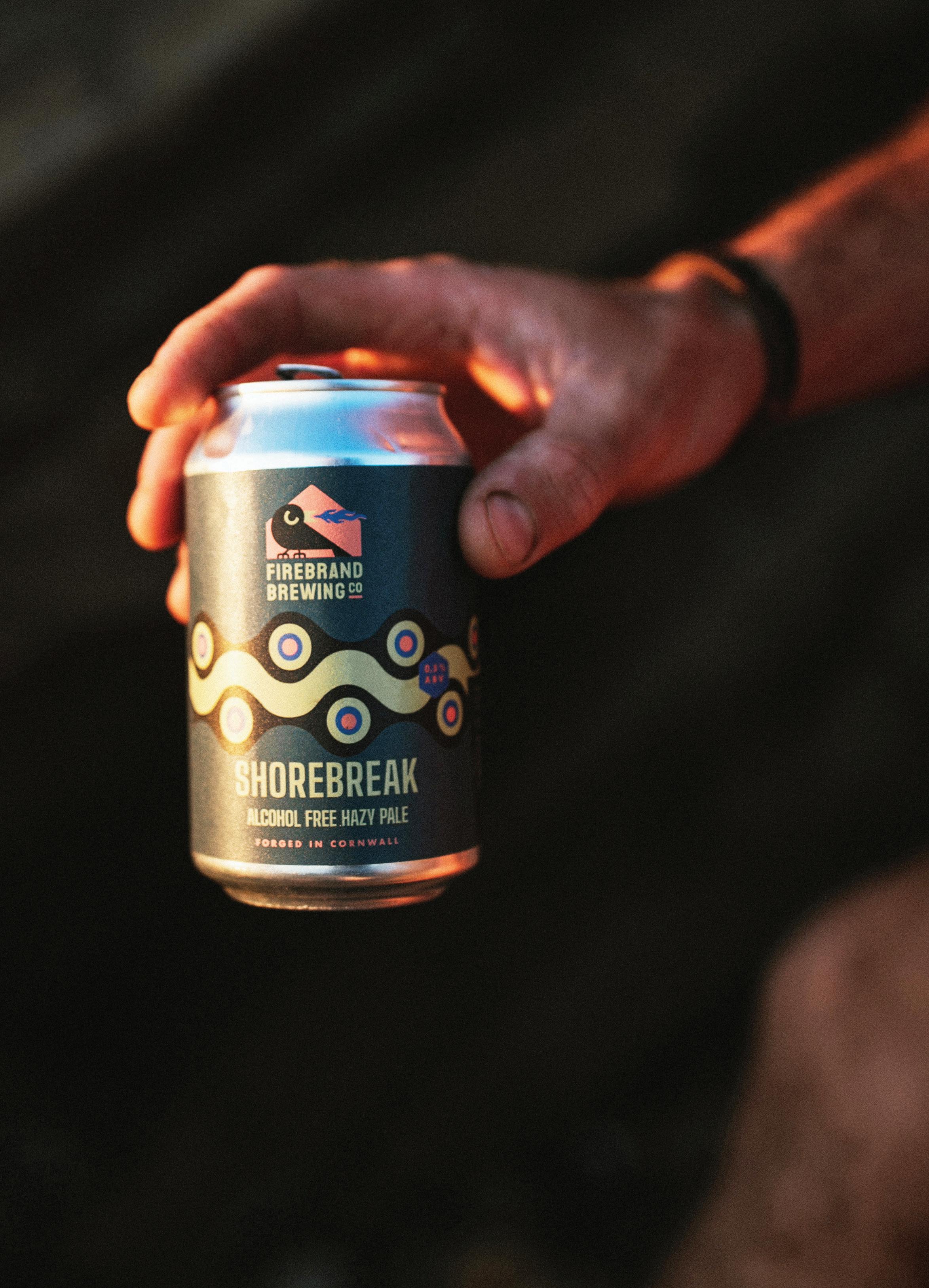
37 / TRIED & TESTED
‘A self‑righteous air and the healthful advantages of relegating booze to the weekend’
5 of the best SMALL-PLATE RESTAURANTS

There's nothing new about small-plate dining; Mediterranean cultures have been doing it for centuries. However, the trend for sociable feasting where everyone digs in is dethroning the traditional three-course formation. Kathryn Lewis reveals some of the best venues where you can lean into this laid-back dining style

1Cor,Bristol






It can be hard to keep up with the Bristol food scene, but if there's only space for one new opening on your 2023 hit list make it Cor.



The neighbourhood restaurant on North Street is the first solo project from chef Mark Chapman and wife Karen. Before opening Cor, Mark was executive chef at a string of the city's most exciting restaurants including Gambas, Cargo Cantina, and Masa + Mezcal.
At Cor, he blends his broad experience with flavours of the Mediterranean to create a sprawling menu of small plates. Sustainability is also a big driver for the chef, so seasonal ingredients sourced from small‑scale producers usually take the lead. correstaurant.com












38 / ISSUE 194
2 Andria, Dartmouth
The estuary town of Dartmouth isn't short on fabulous places to dine while overlooking the water, but those in the know eschew those views for a table at this backstreet bistro.
Born in Paris to Italian parents and trained in the UK, chef owner Luca Berardino merely has to retrace his roots to find inspiration for the European menus at Andria.
Luca has taken the small‑plates format and refined it, serving a daily changing tasting menu where guests are encouraged to share a few dishes at each course.
Given its location, it's no surprise that the menu swims with seafood from Brixham Fish Market. Dishes such as monkfish with chicken jus and hispi cabbage are supplemented with meat and vegetarian dishes like confit leeks with capocollo, pear and smoked butter sauce. andriadartmouth.com
3 Outlaw's Fish Kitchen, Port Isaac
You'll need to book in advance to secure one of the seven tables at Nathan Outlaw's tiny 20‑seat restaurant in the heart of Port Isaac, but forward planners will be rewarded with a phenomenal feast of unique seafood dishes.
Nathan and co are serious about sustainability, only sourcing native fish species from local inshore dayboats. The Port Isaac fishermen's haul is transformed into a set menu of small plates designed to be shared.
The entire experience is attractive, intimate, casual and – thanks to Nathan's determinedly pared‑back cooking which puts all the focus on the ingredients – pleasingly rustic. outlaws.co.uk
4Argoe, Newlyn
Located just metres from Newlyn's bustling fish market and co‑owned by an experienced fishmonger, this contemporary restaurant is an under‑the‑radar find for beautifully unfussy seafood.
Its small plate set‑up allows diners to explore all corners of the menu, which is split into snacks, plates, grilled dishes and sides. Naturally, fish takes the lion's share of the list, with the best of the local dayboats' catch earning top billing.
Order a glass of minimal‑intervention wine and tuck into an array of dishes such as deep‑fried anchovies with caper mayo, and ling with lardo and roasted garlic. argoenewlyn.co.uk
5 Lilac, Lyme Regis
Fans of the innovative tasting menus at Robin Wylde in Lyme Regis can experience a more relaxed, bite‑size version of Harriet Mansell's cooking at its sister restaurant Lilac.
Down the road from the flagship venue, the small‑plates restaurant and wine bar has the same ultra‑seasonal ethos but in a more laid‑back format and environment.
The evening line‑up evolves daily and covers everything from delicious morsels to pick at to dishes for the table such as Balwyn hogget ragu with roasted aubergine and ‘fetish’, and pan‑fried hake with creamed spinach and pangrattato. lilacwine.co.uk
39 / 5 OF THE BEST
WEEKEND COOKING
Recipes from the South West's leading chefs and producers



40 / ISSUE 194
Khoresh bademjan
Recipe by Kate Attlee, founder of Sabzi delis in Truro and Falmouth
Serves 6
Ripe aubergines 2 large, peeled and sliced lengthways (approx. 1cm thick)
Salt Lemon 1, juice
Olive oil
Onion 1 large, peeled and diced Black pepper
Garlic 2 cloves, peeled and finely chopped Turmeric 1½ tsp
Garam masala 2 tsp
Cinnamon ¼ tsp Honey 2 tbsp

Dried limes 2, pierced with a knife
Dried red lentils 200g
Chopped tomatoes 1 tin Tomato puree 2 tbsp Lime 1, juice
1 Lay the aubergine slices on a platter and sprinkle with salt and lemon juice. Leave for 10 minutes, then flip the slices and repeat.
2 Put a glug of oil in a wide bottom casserole dish over a medium heat. Gently fry the onion and season generously with black pepper, but only a pinch of salt (the aubergines will add salt to the dish later).
3 Once the onion is soft, add the garlic, turmeric, garam masala and cinnamon. Allow the spices to sizzle for a couple of minutes, then reduce the heat and pour in the honey – add a splash of water if it starts to stick.
‘This stew is wonderfully substantial –delicious served alongside other Persian dishes or simply piled on hot, buttery rice,’ says Kate
4 Once the garlic is cooked through, add the dried limes and lentils and stir continuously for 1 2 minutes (you might need to add another splash of olive oil). Add the chopped tomatoes, tomato puree, lime juice and a can of water. Season with black pepper and bring to the boil, then turn down to a simmer. Cook for 45 minutes, stirring regularly and topping up with water if needed.
5 In a large frying pan, fry the aubergine slices in oil until golden on both sides. Remove the slices from the pan and place on kitchen roll to drain off any excess oil.
6 Preheat the oven to 170°C / gas 3. Check the lentils are cooked through then layer the cooked aubergine slices on top of the tomato sauce. Place a lid on the casserole dish and cook for 1½ hours.
sabzideli.co.uk
41 / WEEKEND COOKING
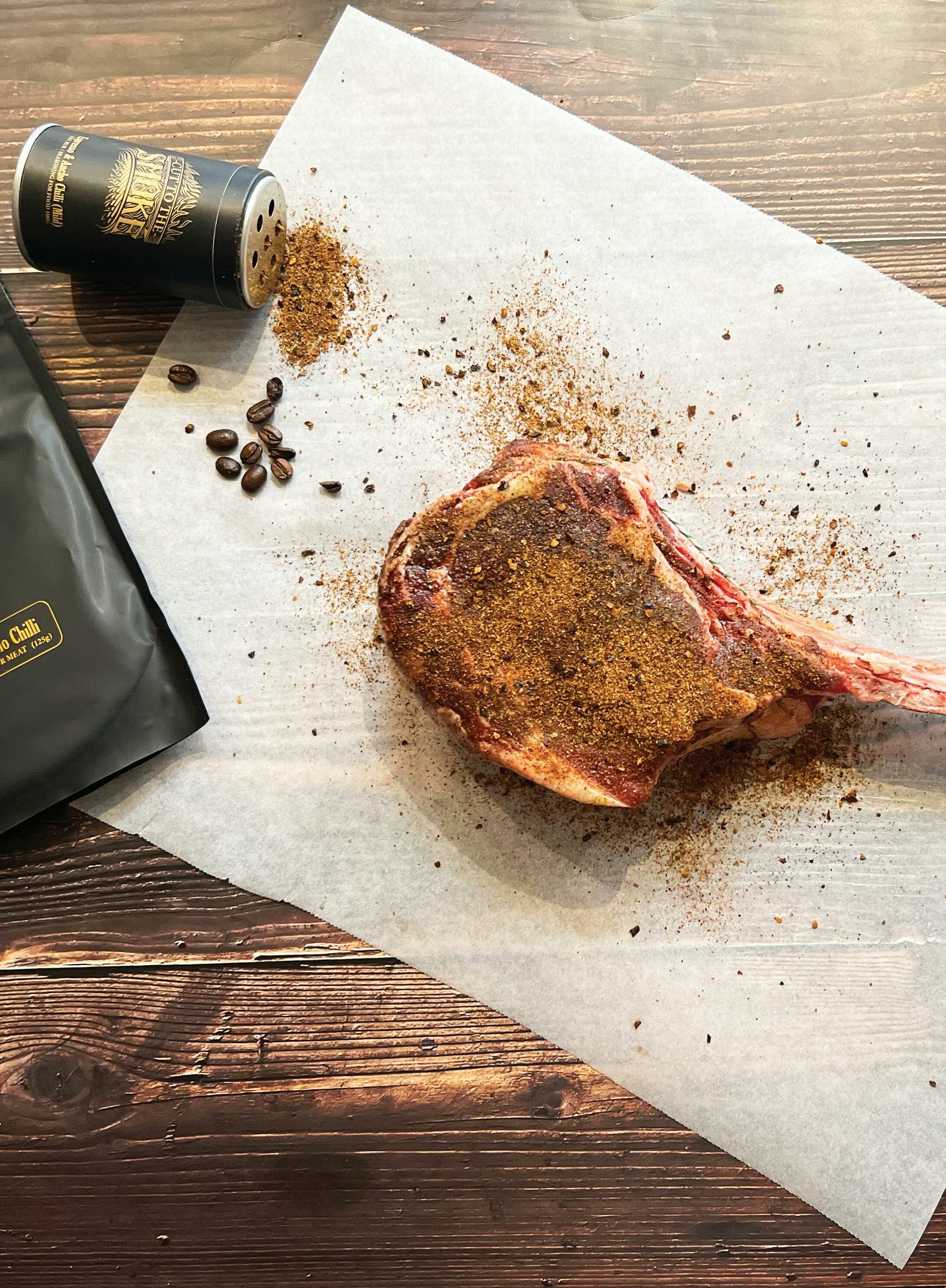
42 / ISSUE 194
‘This spice mix will bring out the earthy flavours of the beef, followed by subtle heat and sweetness,’ says Nigel
Espresso and ancho chilli tomahawk steak with triple‑cooked chips
Recipe by Nigel Webster of Cut to the Smoke
Serves 3-4
Tomahawk steak 1kg Cut to the Smoke Espresso and Ancho Chilli spice mix 50g Maris Piper potatoes 1kg, peeled Vegetable oil Coarse sea salt
1 Season the steak with the spice mix, making sure to cover all of the edges, then place in the fridge and leave to marinate over night.
2 Cut the potatoes into chips around 1½cm thick, then wash under cold water to remove any excess starch.
3 Put the chips in a large pan of cold water and place over a medium heat for 10 15 minutes, ensuring the water doesn't boil. Remove the chips from the pan and place on a cooling rack to dry off, then put in the fridge for 45 minutes.
4 Put the vegetable oil in a large saucepan over a medium heat and bring to 130°C. Remove the chips from the fridge and carefully place in the hot oil. Cook for 5 7 minutes until just starting to colour. Remove the chips from the oil (reserve it for later) and place them on kitchen roll to drain off any excess oil.
5 Remove the steak from the fridge 30 minutes before cooking so it comes up to room temperature. Heat the barbecue to 180 200°C, or until the coals are white. Alternatively, you can cook the steak in a griddle pan on the hob.
6 Once the barbecue/griddle is hot, sear all sides of the steak for 3 4 minutes until it takes on a deep colour. For a medium finish, continue to cook the steak for around 6 minutes on each side. Remove from the heat and wrap in foil while the steak rests.

7 Put the pan with the vegetable oil over a medium heat and bring it to 180°C. Fry the chips in small batches for 5 6 minutes until golden brown. Remove the chips from the oil and drain them on kitchen roll, then sprinkle with coarse sea salt.
8 Slice the steak along the bone, then into thick horizontal slices. Serve with the chips and your favourite sides.
cuttothesmoke.co.uk
43 / WEEKEND COOKING
THE DRINKS CURATOR



























Drinks pro Susy Atkins reveals her seasonal pick of the pack



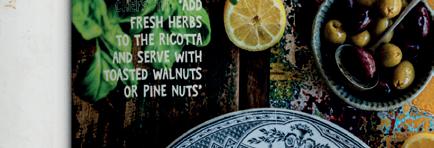

PENTIRE ADRIFT
















































































































































There are plenty of “grown‑up” non‑ alcoholic drinks to choose from now, but one of my firm favourites is Pentire Adrift from north Cornwall.




It's made with botanicals from local coastal headlands, including rock samphire, sea rosemary and sage, and has a gentle, natural herbal quality. A smidge of sea salt and dash of citrus has been added so the finish is super fresh and clean. Splash it instead of gin if you're doing Dry January, or just because it's utterly delicious.












£26.80 pentiredrinks.com
recipes?
Looking for veggie and vegan
indycoffee.guide out now
44 / ISSUE 194
Discover tonnes of casual and easy‑to‑make dishes from some of the UK’s best cafes
£20. Order now at
Shoreside Spritz
 Recipe by Holly Bennetts, head mixologist at The Greenbank in Falmouth
Recipe by Holly Bennetts, head mixologist at The Greenbank in Falmouth
Makes 1
Pentire Coastal Spritz 50ml Chai tea 50ml, chilled Minus 8 Maple Brix Verjus 200ml Smoked Cornish Sea Salt a pinch Ginger ale 100ml Fig 1 sliced, to garnish
1 Fill a large wine glass with cubed ice.
2 Pour the Pentire Coastal Spritz, chai tea and verjus into the glass then, using a bar spoon, stir in the sea salt.
3 Top with ginger ale. Stir again, making sure to reach the bottom of the glass so all of the ingredients are combined.
4 Add more ice if needed and garnish with fig slices.
greenbank-hotel.co.uk
45 / WEEKEND COOKING
‘This alcohol‑free aperitivo is inspired by the flavours of the season and makes a vibrant spritz,’ says Holly
DINING THROUGH THE DECADES
Matt Mason, executive chef of Winslade Manor near Exeter, reveals how his love affair with fine dining has been stoked by some sublime – and not so sublime – dining experiences

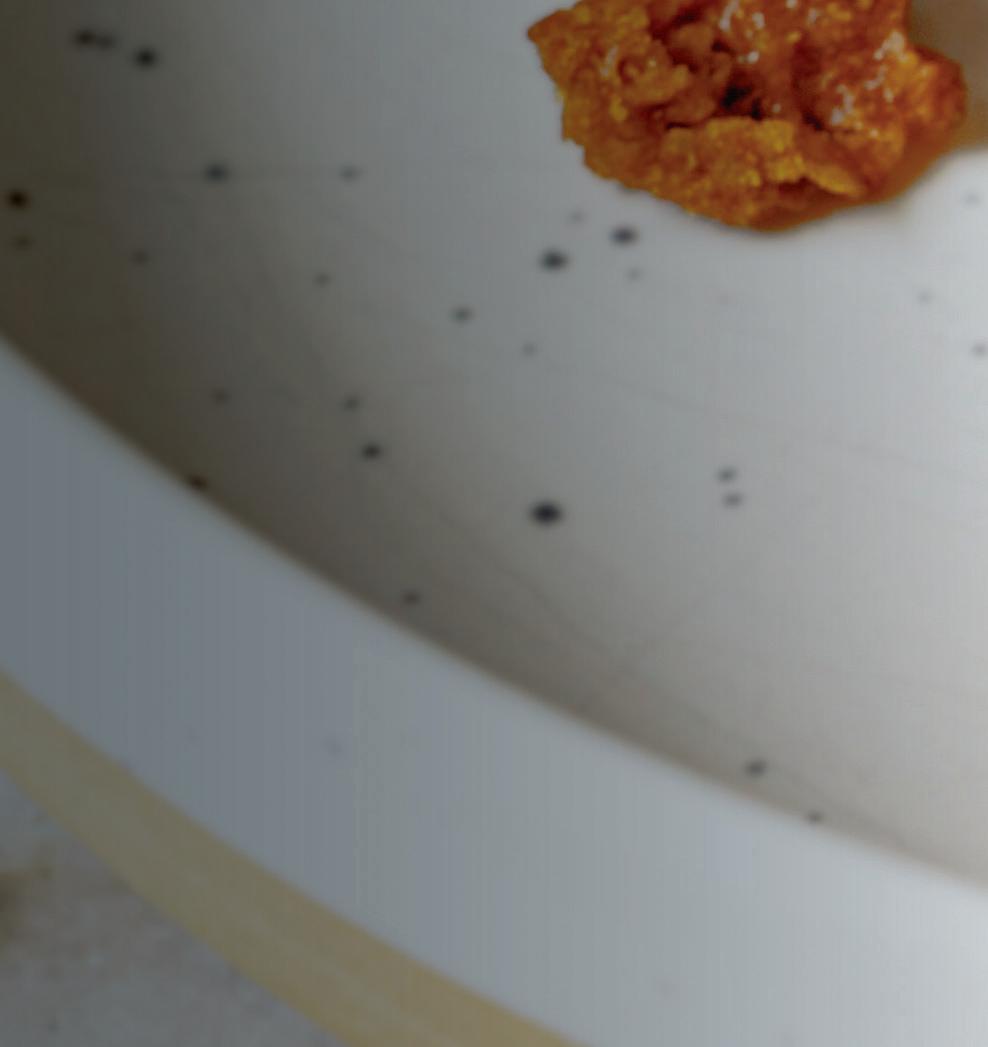
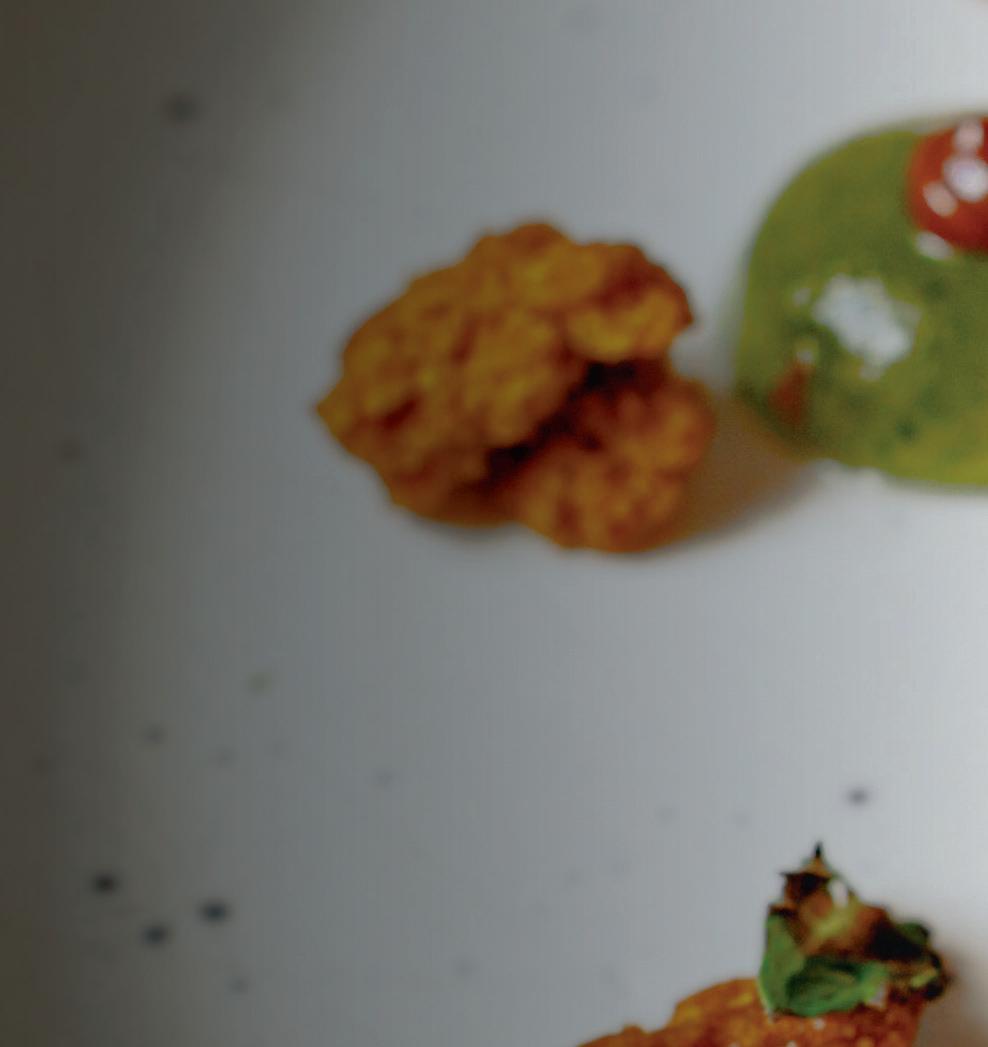

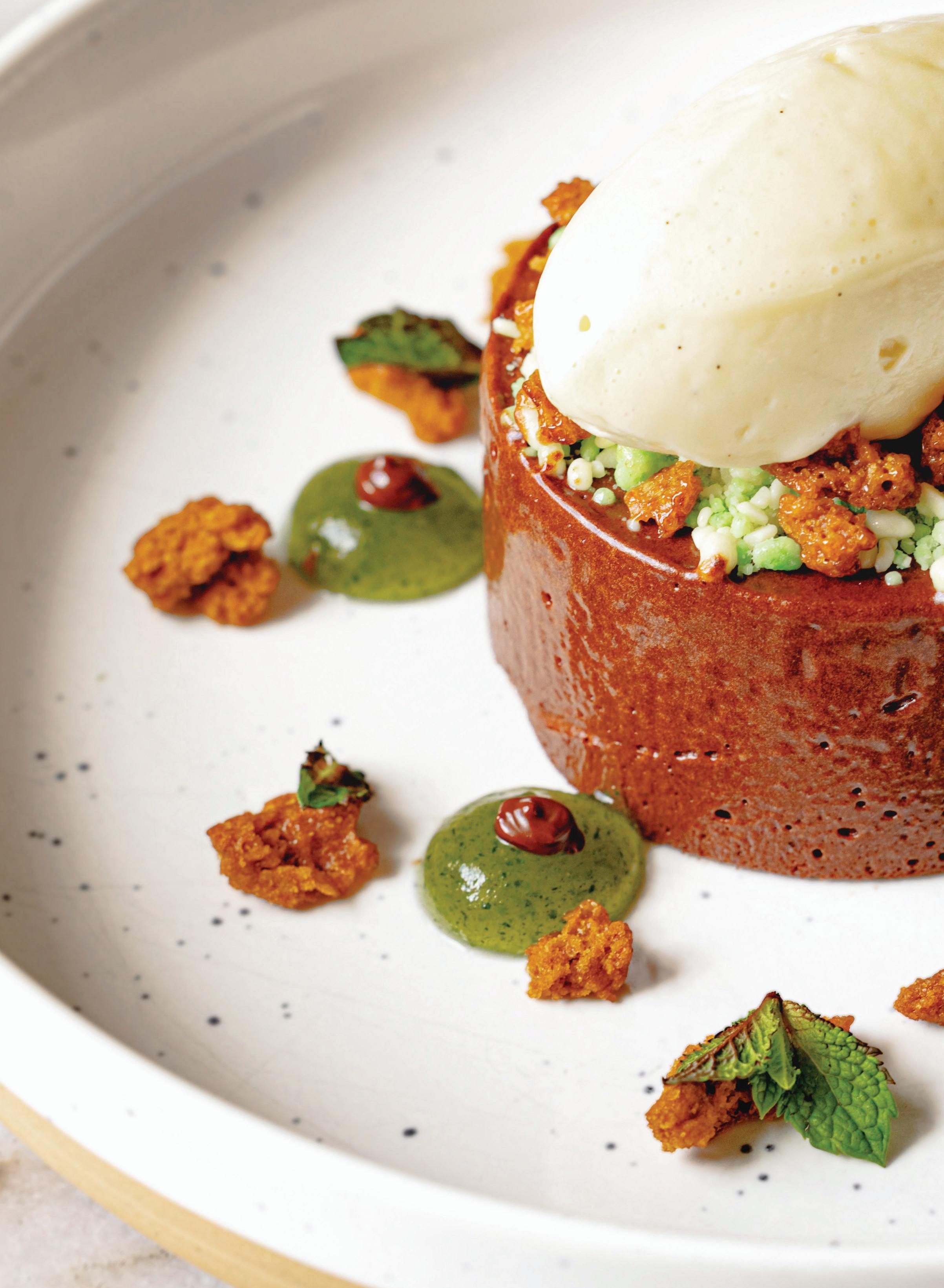
46 / ISSUE 194
HARVEYS, LONDON
In 1990, Matt had his first fine dining encounter on his 18th birthday. The meal at Marco Pierre White's two Michelin starred restaurant Harveys is still imprinted on his memory partly due to the superb French cuisine and partly due to the fact that his table was right next to one occupied by the actress Joan Collins.
‘I can still remember every dish: the main course of Bresse pigeon with foie gras was like nothing else I had ever eaten,’ he says
CHEZ NICO, LONDON
By 1996, the chef's love affair with fabulous food was firmly entrenched, so he and a good friend drove to London for a hugely anticipated lunch cooked by Nico Ladenis at three Michelin starred Chez Nico.

‘Unfortunately, my friend started to get a migraine and, just as starters arrived, he vomited all over the table,’ recalls Matt. ‘Needless to say, we couldn't get out of there quickly enough!’
LA TANTE CLAIRE, LONDON
The chef visited another three Michelin starred London restaurant in 1998, this time to feast on the signature dish of renowned chef Pierre Koffmann.
‘Back in the day, I would never leave a great restaurant without taking a menu - often signed by the chef and hoarded like a trophy.
‘We ate pied de cochon - braisé au porto, farci de ris de veau et morille. It was Koffmann's celebrated dish of stuffed pig's trotters with veal sweetbreads and morels. The combination of flavours absolutely blew my mind.’
THE IVY, LONDON
Matt also recalls many magical evenings spent celeb spotting in iconic West End restaurant The Ivy in the early 2000s.
‘I remember having a few too many Bloody Marys and Porthilly oysters while sitting next to Boy George, having just watched him in his West End hit Taboo. What a night that was!’
LE LOUIS XV - ALAIN DUCASSE À L'HÔTEL DE PARIS, MONTE CARLO
Matt's most expensive meal to date was during the 2003 Monaco Grand Prix at the three Michelin starred Le Louis XV.
‘Ironically, my wife was eight months pregnant with our first child so she barely ate a thing,’ he says. ‘At first, I nearly wasn't allowed in as I didn't have a dinner jacket; I had to borrow one from reception and it was about ten times too big.’
LE GAVROCHE, LONDON
In 2005, Matt and Paul Parnell (owner of The Jack in the Green near Exeter where Matt was head chef at the time) celebrated being included in the list of Top 50 Gastropubs with lunch at two Michelin starred Le Gavroche.
‘Legendary French chef Albert Roux joined us for the cheese course and then proceeded to happily wine and dine us for the next few hours,’ recalls Matt. ‘For a young chef, it was the stuff of dreams.
‘The dish of coquille st jacques aux parfume des truffe was incredible. It was the most beautiful hand-dived Cornish scallop cooked in its shell with lashings of fresh truffle, served tableside with wonderful theatre.’
TOM AIKENS, LONDON
Matt also has fond memories of accompanying Scott Paton (now head chef at Àclèaf at Boringdon Hall Hotel near Plymouth) for a two Michelin starred experience at Tom Aikens in 2010.
‘Scott was a very fresh-faced impressionable young man back then, but just look at the seed that was planted all those years ago. He is now achieving the kind of accolades we aspired to, and were inspired by, back then.’
WD~50, NEW YORK
After taking part in the 2010 New York City Marathon, Matt capped a brilliant weekend with a visit to wd~50 where Wylie Dufresne took an unusual approach to the cooking. The chef's menus were famous for being a madcap mashup of science, art and humble classic food.
‘We ate a crazy dish of cold fried chicken, buttermilk ricotta, Tabasco and caviar, which gave me a sense of the kind of chef he was. This was food - but not as I knew it.’
EL BULLI HOTEL - HACIENDA BENAZUZA, SEVILLE
Matt also recalls a particularly intense dinner when he sampled the cooking of renowned chef Ferran Adrià Acosta at a five star Spanish hotel.
He confesses: ‘To be painfully honest there were about 50 courses and we lost interest at around dish 30.’
winslademanor.com
47 / SUPPORTED CONTENT




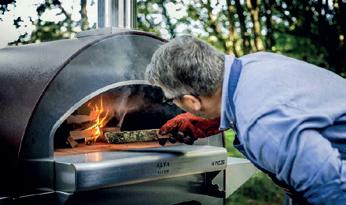




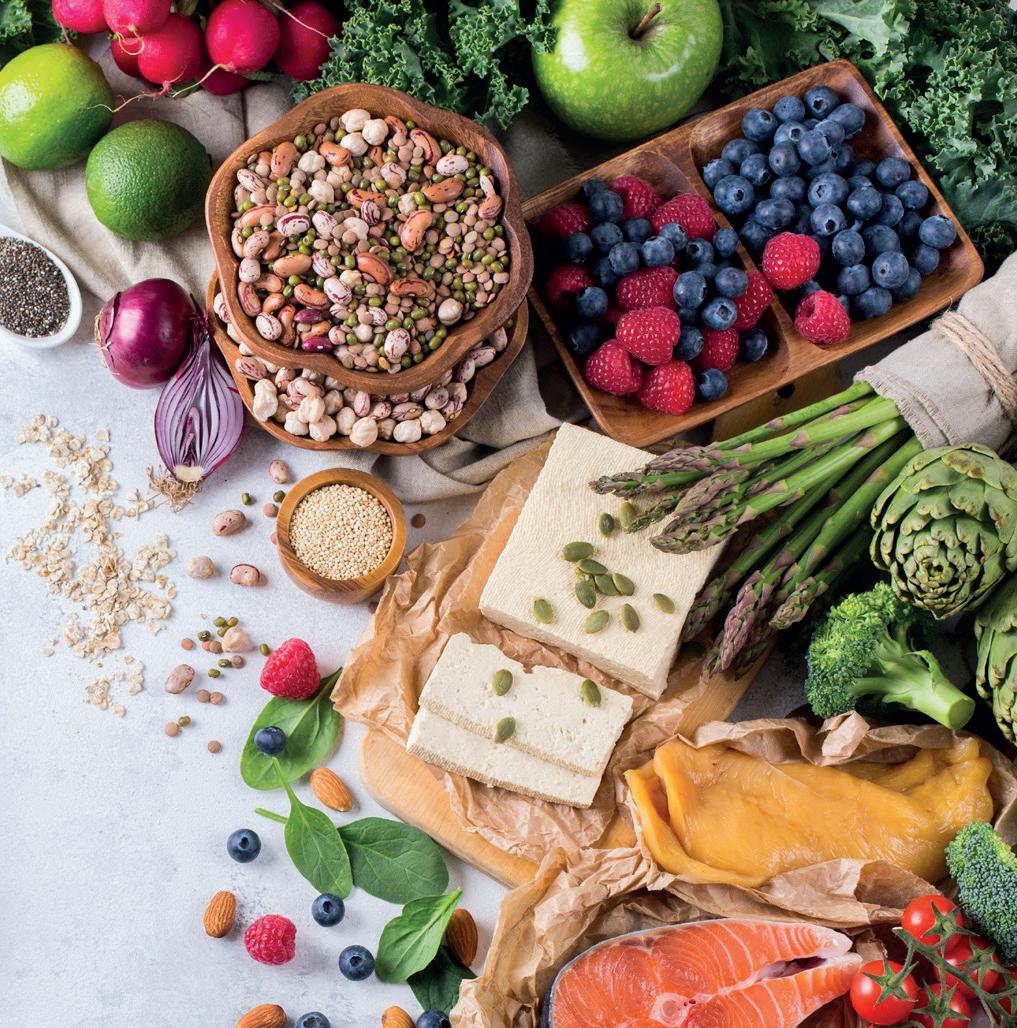









48 / ISSUE 194 UNIT 3A | WEST DEVON BUSINESS UNITS NEET WAY | HOLSWORTHY INDUSTRIAL ESTATE HOLSWORTHY | DEVON EX22 6ES 01409 251357 WWW.HEARTSMOKESOAL.CO.UK WE DESIGN AND BUILD LUXURY BESPOKE OUTDOOR KITCHENS FOR THE ULTIMATE IN OUTDOOR LIVING NEW BBQ COOKERY SCHOOL FOR 2023 SEE WEBSITE FOR DETAILS WE HAVE THE PRODUCTS TO IGNITE YOUR AL FRESCO EXPERIENCE! www.marshford.co.uk 01237 477160 Churchill Way, Northam, North Devon EX39 1NS Organic veggies, salads and herbs (many homegrown), plus local fish, meat, eggs, bread and groceries are all available from our Northam store. Order online for collection or local deliveries Award-winning seafood restaurant and oyster farm overlooking Chesil Beach on the Jurassic Coast crabhousecafe.co.uk 01305 788867 @CrabHouseCafe thecrabhousecafe
PLAYING WITH FIRE
One of Devon's most exciting openings in the pandemic period wasn't a fancy fine dining restaurant or a cool cafe on a famous surf beach. Instead, the prize went to a somewhat hidden eatery in the rambling rural countryside which celebrates cooking over flames.
The Lost Kitchen, an informal and rustic feasting barn in the wilds of Chettiscombe near Tiverton, is the embodied vision of wife and husband team Aurora and George Aykroyd. Their ambition was to create a restaurant centred on fire, place and purpose – and they've delivered in spades.


The project combines the talents of Aurora, a chef passionate about modern European cuisine, and George, a builder turned wood fired cooking expert. Together, they've created something very special.
‘The Lost Kitchen is a place that should feel familiar, as it captures the “sense of place” of Devon,’ says Aurora. ‘The food is a delicious celebration of the ingredients grown on our doorstep and of cooking with fire.’
Later, the couple joined forces with renowned chef Sally Edwards at Moorish in Wiveliscombe where they honed their wood fired cooking skills, before going on to run Scarlett's Garden, a cafe in Langford Budville. Then, ten years later, an opportunity arose to set up a new business in an old barn in the tiny village of Chettiscombe. The pair made the leap and The Lost Kitchen was born, with George and a local team of craftspeople hand making its furniture, fixtures and fittings from reclaimed wood.
Aurora, who is half French, started her culinary career training as a chef in the French Alps. On her return to England she met George ‘at Tracebridge Sourdough, a magical local bakery in a forest near Wellington’.
At the time, George was helping the bakery to build a mobile oven so the team could cater at events. It soon became clear the pair could work together. ‘We set up a sourdough pizza business, which then led to new projects,’ George explains.
‘I wanted to create a place where people could visit in welly boots for coffee and cake after a walk, as much as for a celebratory meal in their Sunday best,’ he says.
Aurora oversees the kitchen and gardens, where some of the seasonal produce is grown. Meat is locally sourced from Veyseys Butchers in Cullompton and Beech Ridge Farm in Hockworthy, while seriously good bread comes from Wiveliscombe's Longstraw Bakery. The pizza dough is crafted on site.
The resulting experience is creative yet informal with the wood fired oven the focal point. George explains: ‘Fire never disappoints with its flicker of flame and full-bodied heat. Having an open-plan kitchen with a wood oven in the middle puts the drama and spectacle of cooking with fire front and centre.’ lostkitchen.co.uk

The Lost Kitchen, a rustic restaurant delivering wood fired cooking, is setting the Devon dining scene alight
49 / SUPPORTED CONTENT
‘THE DRAMA AND SPECTACLE OF COOKING WITH FIRE’
NEW and in our showrooms now! e all electric range cookers from Rayburn and ESSE.







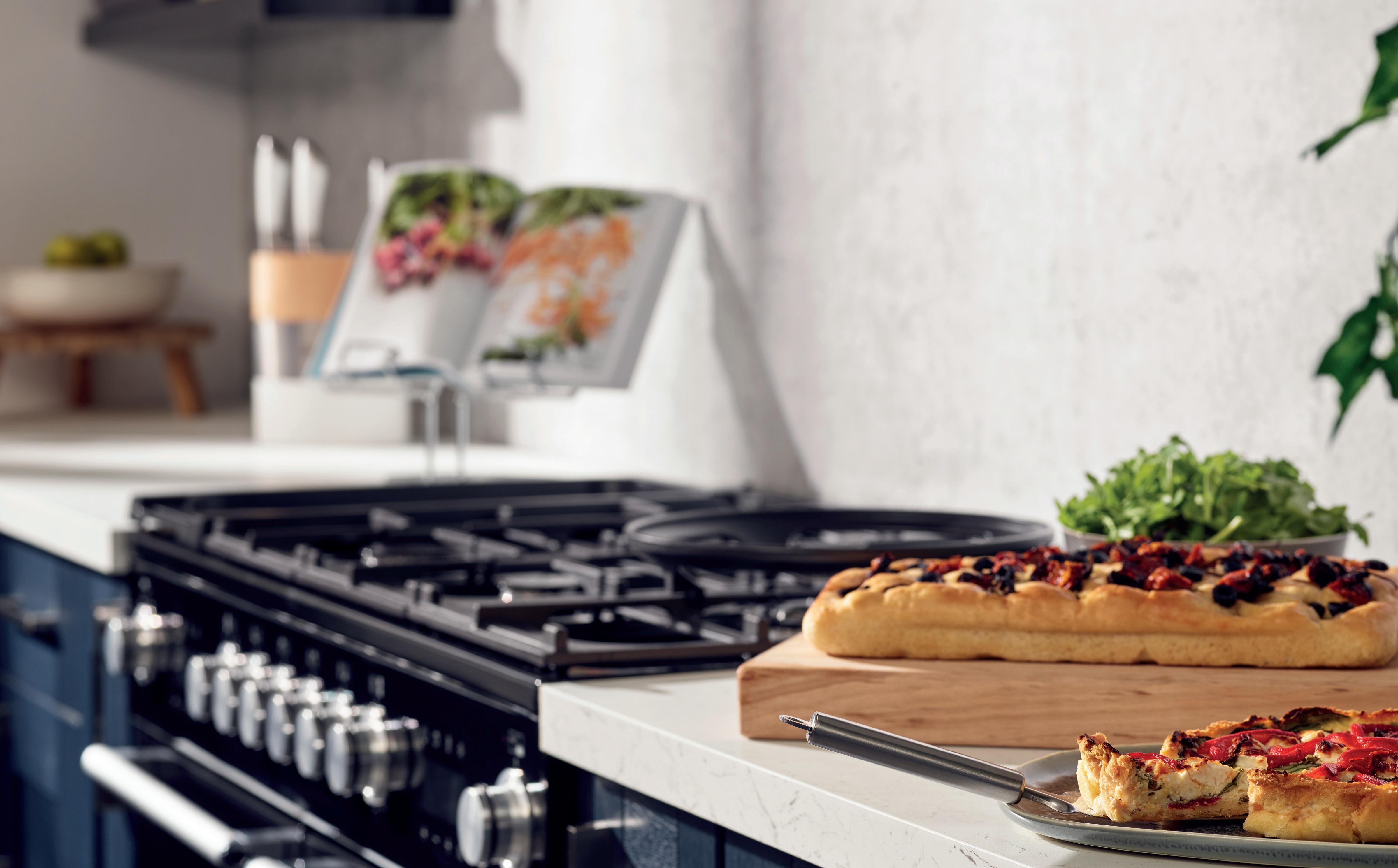
ESSE • FALCON • LACANCHE • LA CORNUE • MERCURY • RAYBURN • RANGEMASTER
Range cookers from
Whether you’re cooking a sumptuous roast for the family or creating a special culinary treat for friends, we have the perfect cooker for you. Cookers that will bring out the very best in your cooking and will add a delicious focal point to any home. For expert advice and to explore one of largest collections of appliances in the South West, visit Rangemoors.




Call 01837 680068 • www.rangemoors.co.uk Main Winkleigh Showroom. The Airfield, Torrington Rd, Winkleigh, Devon EX19 8DW Exeter Showroom. 14 Oaktree Place, Manaton Close, Matford, Exeter, Devon EX2 8WA FOR THE COOKING YOU LOVE e home of range cooking. The Cookers you’ll ador e













www.rivierafoodmusicfest.co.uk @Riviera_Fest @rivierafoodmusicfest @rivierafoodmusicfest A BRAND-NEW FOOD AND MUSIC FESTIVAL, IN THE HEART OF TORBAY, SHOWCASING THE SOUTHWEST’S FINEST FOOD, RESTAURANTS AND CHEFS, ALONGSIDE AN AMAZING LINE-UP OF THE UK’S BEST MUSIC ACTS. SIGN UP FOR EXCLUSIVE ACCESS TOTICKETSPRE-SALE ALREADY ANNOUNCED Discover southern England and South Wales' best speciality coffee shops and roasteries £9.99 indycoffee.guide the south & SoUTH WALES independent coffee guide the south & south wales #7 DoN’T Set TlE FoR SuB-StANdARd 52 / ISSUE 194
WIN a Hix seafood feast






Perched on a hill overlooking the Jurassic Coast, chef Mark Hix's flagship restaurant, The Oyster & Fish House, welcomes guests to its glass-encased dining room with exceptional views of the briny blue beyond.
While the dreamy vistas are worth paying a visit for, it's the phenomenally fresh fish and seafood that's the real draw. The menu changes daily to reflect the local catch (often sourced direct from the waters of Lyme Bay), which suits Hix's pleasingly unpretentious style of cooking. Whole grilled plaice with black butter and capers, and River Fowey mussels with Burrow Hill cider and chervil provide a snapshot of what you might expect on the line‑up.
Pay a winter visit to enjoy a set lunch or indulge in the midweek meat night, where a set menu of locally reared meat dishes steals the spotlight for the evening. If you're mad about molluscs, stop by for Oyster Happy Hour from 3pm‑6pm Tuesday to Friday (until the end of March). Chow down on half a dozen oysters and a glass of sparkling wine for just £15.
Look out for guest‑chef nights too, which run throughout the year and feature the likes of Richard Bertinet, Nathan Outlaw, Harriet Mansell and Naomi Devlin – see the website for dates and tickets.




If you can't make it to the Lyme Regis restaurant in person, sample Mark's fish at home via Hix Smokin' House, a new range of smoked fish products crafted in partnership with Chesil Smokery in nearby Bridport and available to order online.
THE PRIZE A £150 voucher to spend at The Oyster & Fish House, plus a smoked‑fish hamper from Hix Smokin' House.
THE QUESTION In which Dorset seaside town will you find The Oyster & Fish House?
To enter, visit food‑mag.co.uk/win
See the website for individual terms and conditions. Closing date for entries is February 28, 2023.


theoysterandfishhouse.co.uk





53 / WIN





































DISCOVER Try our fresh new menu, every Sunday from 11:30am-3pm Best served with friends, family and fabulous views. at The Donkey Sanctuary Vegan option pictured. thedonkeysanctuary.org.uk/the-kitchen SIDMOUTH, EX10 0NU A registered charity INFO@LEWTRENCHARD.CO.UK 01566 783 222 WWW.LEWTRENCHARD.CO.UK A LUXURY FAMILY RUN HIDEAWAY IN DEVON 54 / ISSUE 194
WIN
a coastal escape in Cornwall

While surfers flock to St Agnes to ride the waves at Trevaunance Cove and walkers make the trip to traverse the rugged South West Coast Path, beer drinkers make a beeline to Driftwood Spars at the heart of the village to imbibe creative brews.






Combining an iconic pub, a celebrated microbrewery and a B&B with stunning coastal views, it's a little enclave of convivial Cornish hospitality. Even in the depths of winter, this is a cosy port in a storm where you can unwind with a pint (or glass of wine) by a wood‑burning stove as gales and waves rumble outside.
Enjoy a tour of Driftwood Spars' award‑ winning microbrewery where head brewer Mike Mason will recount the story of the brewery and introduce you to his latest creation, Cove: a range of gluten‑free and vegan beers, crafted from the finest British new‑wave hops.
The pub has 15 ensuite rooms where you can rest your head for the night after a beer‑tasting experience. There are also regular live music sessions, comedy nights and other events, so book your stay to coincide. In the morning, tuck into a leisurely Cornish breakfast and be sure to try the moreish Marm‑ale‑ade, made with Driftwood Spars' beer.
Before you head home from your dreamy escape on the Cornish coast, pick up a case of beer from the brewery to take with you – one sip will transport you right back to St Agnes.
THE PRIZE One night's bed and breakfast in a sea-view room, plus a 12-bottle mixed case of Driftwood Spars beers.
THE QUESTION In which Cornish village is Driftwood Spars located?

To enter, visit food‑mag.co.uk/win
See the website for individual terms and conditions. Closing date for entries is February 28, 2023.
driftwoodspars.co.uk

55 / WIN





Planning a gourmet getaway in 2023? Discover 116 handpicked restaurants and foodie hotels of the highest standard Country





Trencherman's Guide and Awards 2023 partners Get your copy of the latest edition of the Trencherman's Guide, plus vote in the second round of the Trencherman's Awards 2023 at trenchermans-guide.com
Lympstone Manor, Devon
Last bite


JAMES CHECKLEY







WHICH KITCHEN ITEM COULDN'T YOU LIVE WITHOUT?
I'd be lost without my knives or my trusty hand blender.

WHAT DO YOU LISTEN TO IN THE KITCHEN?








Right now, it's quite a mix as my sous chef loves Bon Jovi – and I don't. When I get my hands on the speaker it ranges from Al Green to Blink 182, with lots of hip‑hop in between.


CAREER HIGHLIGHT TO DATE?

Without a doubt it was making it to the finals of MasterChef. It was the most amazing experience and I'd encourage any chef to take part.
YOUR MOST-READ RECIPE BOOK?
I absolutely love Out of My Tree, the autobiography and cookbook by Daniel Clifford, and Pollen Street: The Cookbook by Jason Atherton. They are both beautiful books, filled with amazing recipes and insights into the kind of food I love.
FAVOURITE PLACE TO EAT OUT?
I haven't been out to eat in such a long time, but The Rising Sun Inn in Altarnun, Cornwall, was utterly superb when I visited recently. Class from start to finish.
BEST STAYCATION SPOT?
I think Devon is a great staycation spot because we have such amazing food, places to visit and scenery. However, I am biased, so failing Devon I do like going up to London.
GUILTY
FOOD PLEASURE?
KFC. And I don't even feel guilty choosing it!
DESERT ISLAND MEAL?
I like the idea of my partner and me, with a cocktail in hand, enjoying a barbecue on the beach. She eats a plant‑based diet, so at least on a desert island she'd have lots of fruits and veggies to choose from. galleyrestaurant.co.uk
58 / LAST BITE
The MasterChef: The Professionals semi‑finalist reflects on his time on the show and his new role as head chef of The Galley in Topsham
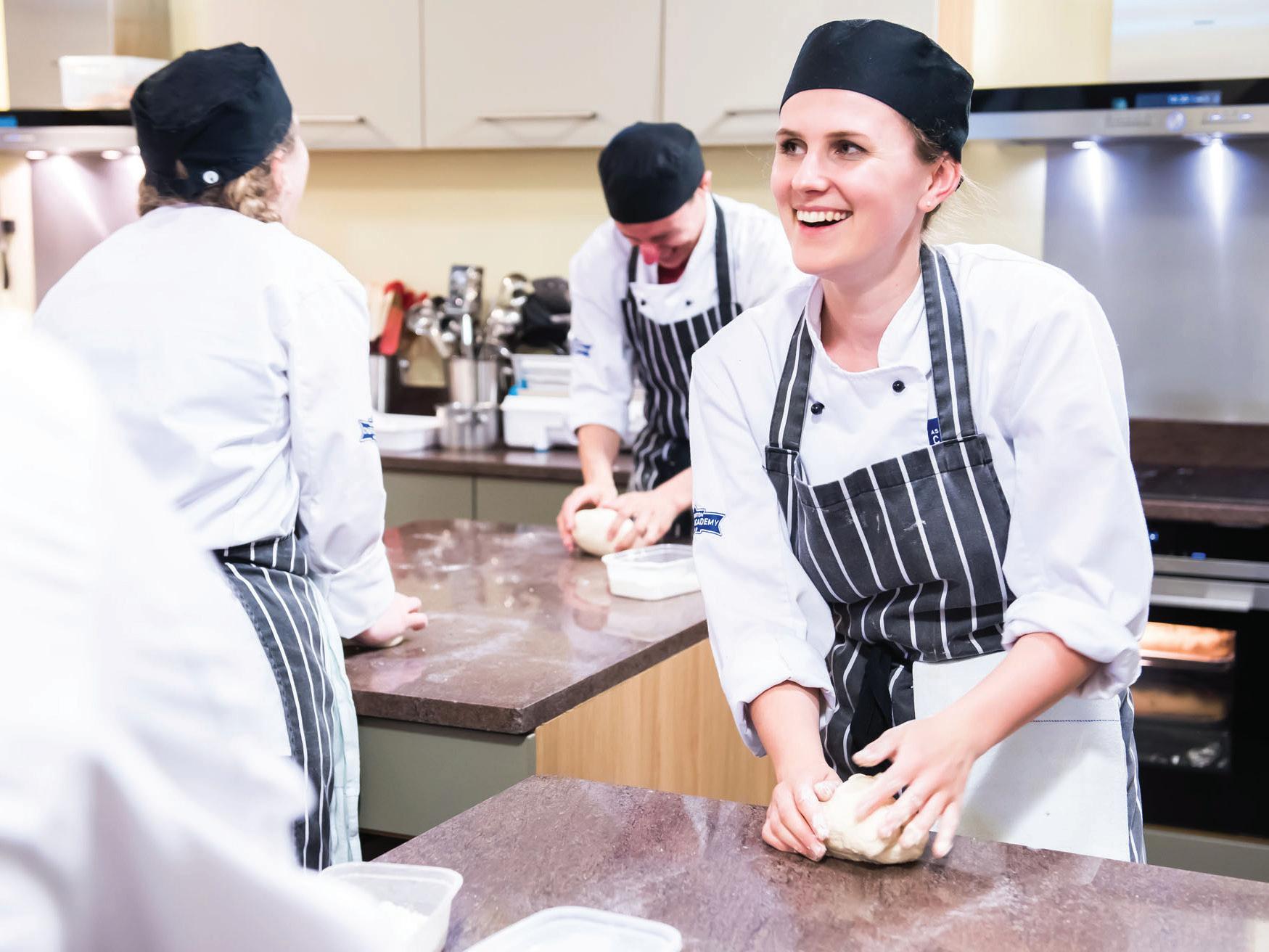
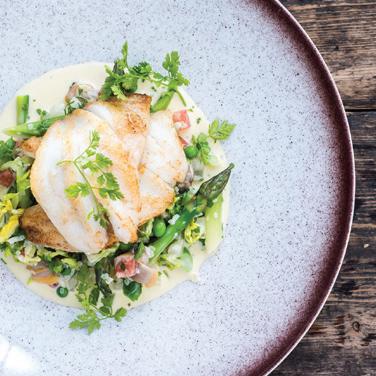
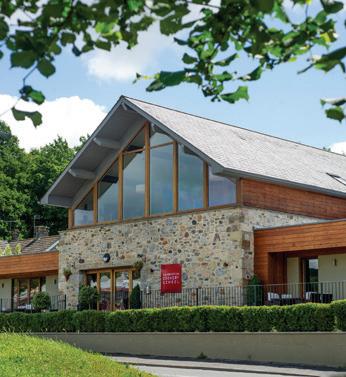
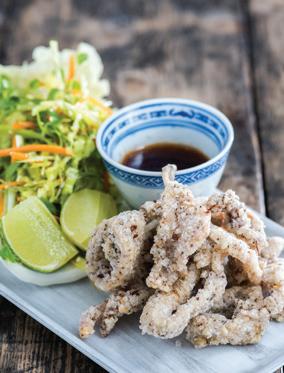




The Ashburton Chefs’ Academy is one of the UK’s leading private culinary schools offering accredited chef qualifications to aspiring chefs. Our inspirational courses range from short skills courses to full-time diplomas in the Culinary Arts or Patisserie and are taught by expert chef tutors using the best ingredients. Visit us online to see how we can help you reach your full culinary potential. Courses enrolling now for 2022. Ashburton Chefs’ Academy Old Exeter Road · Ashburton · Devon · TQ13 7LG · Tel: 01364 652784 www.AshburtonChefsAcademy.co.uk GREAT CHEFS Are Made In Ashburton
Would you like to turn your passion for cookery into a career? Perhaps you dream of running your own bistro, travelling the world as a private chef or launching your own food business.
Golden Wonders





Embrace comfort this winter and enrich your mash, sauces and stews with a spoonful of Trewithen Dairy Cornish clotted cream. There’s no better way to give a creamy, rich and full flavour to your sweet and savoury dishes.






For our polenta and beef stew recipe and plenty more inspiration, head to WWW.TREWITHENDAIRY.CO.UK/RECIPES































































 The Swan Hotel
The Swan Hotel














































































 Jo Rees and Mel Stewart take comfort in that stalwart of the 1970s: the slow cooker
Jo Rees and Mel Stewart take comfort in that stalwart of the 1970s: the slow cooker
















































































































 Recipe by Holly Bennetts, head mixologist at The Greenbank in Falmouth
Recipe by Holly Bennetts, head mixologist at The Greenbank in Falmouth





































































































































































